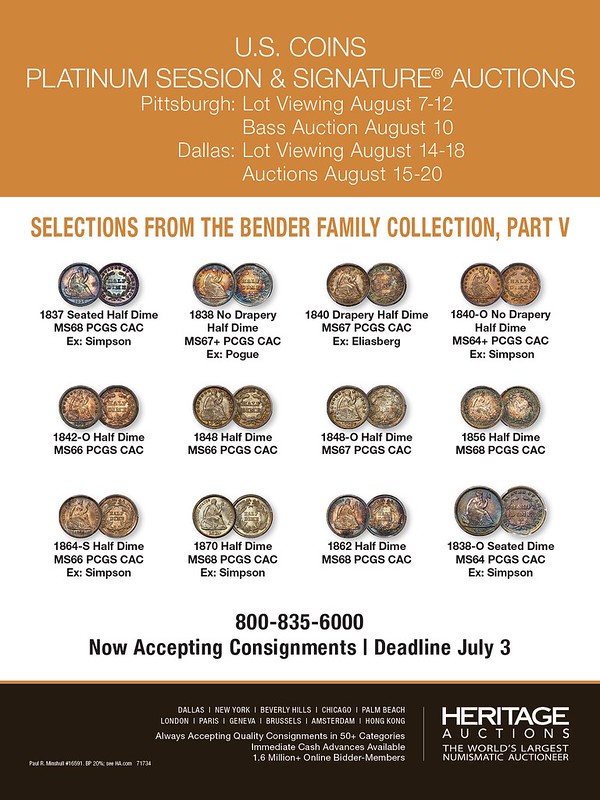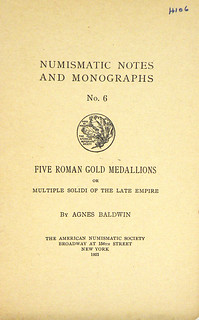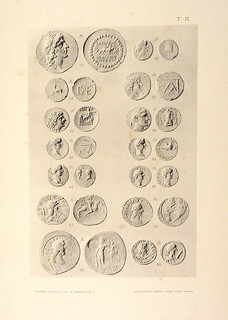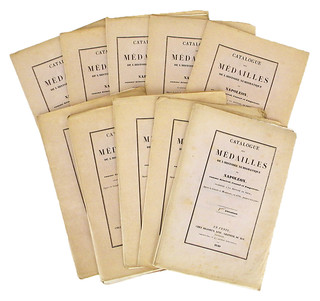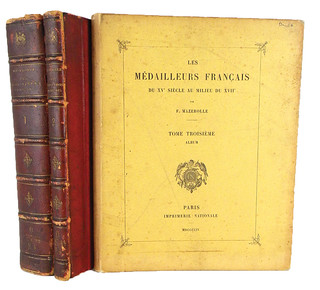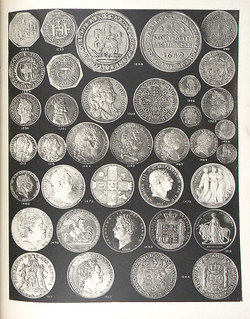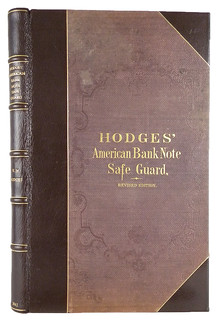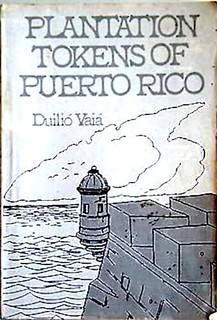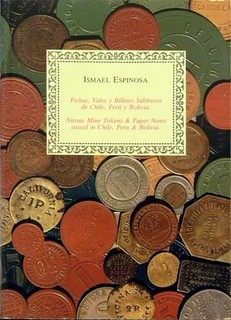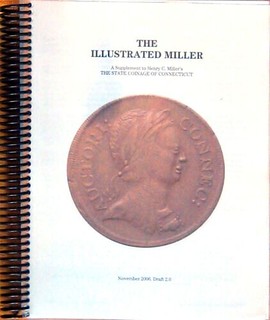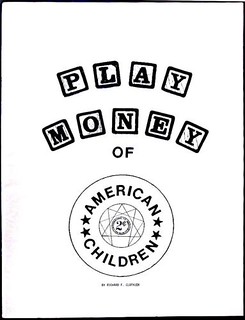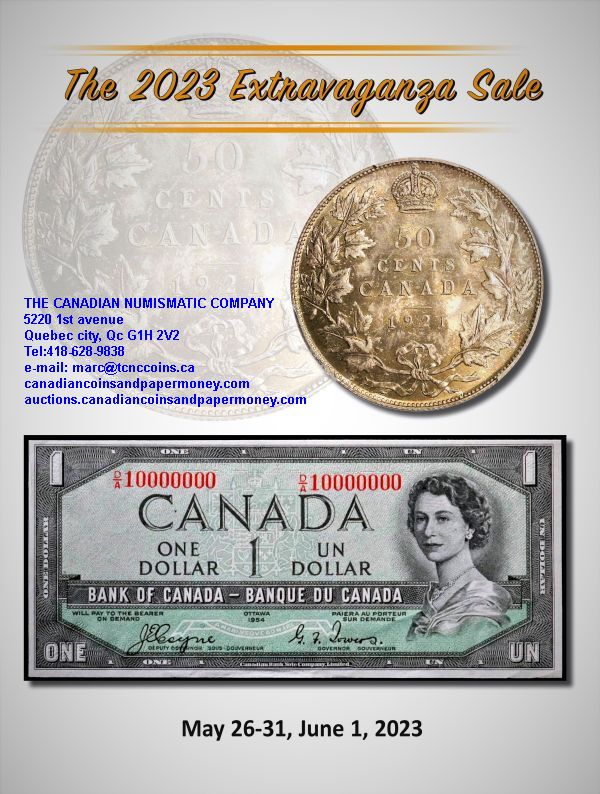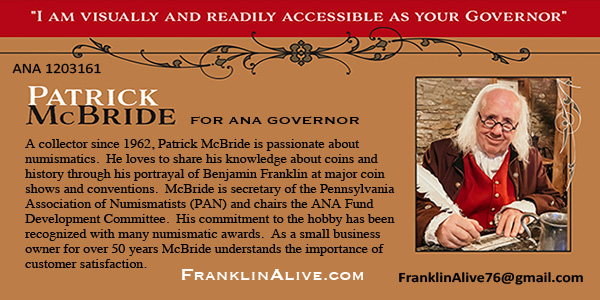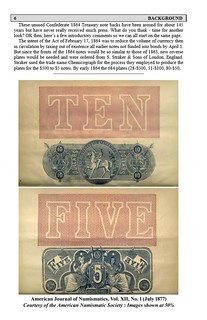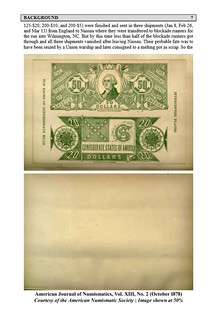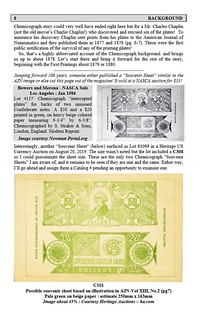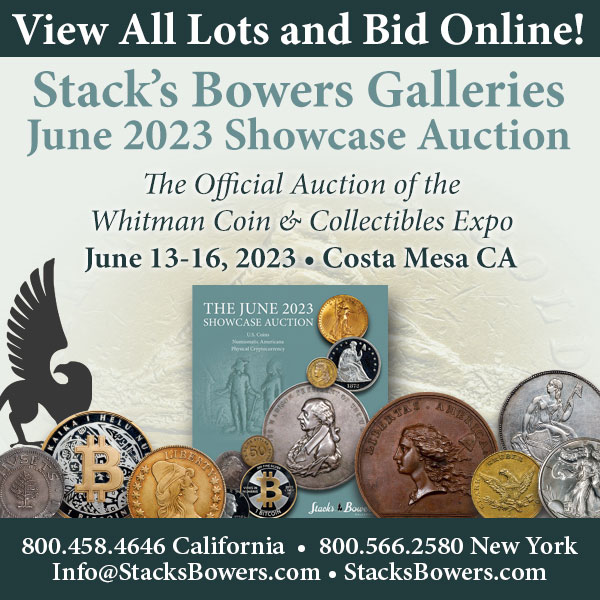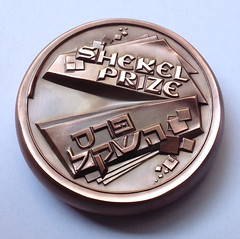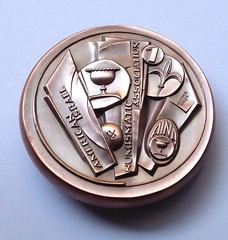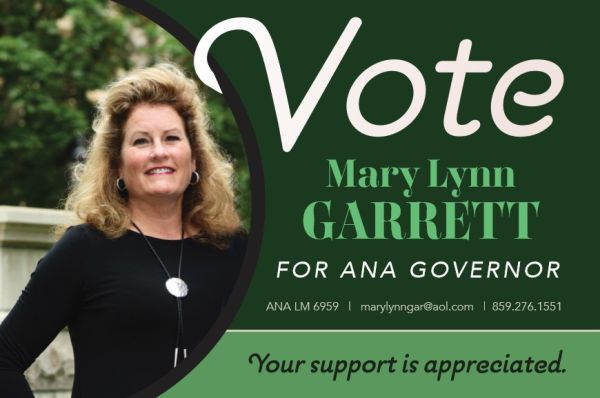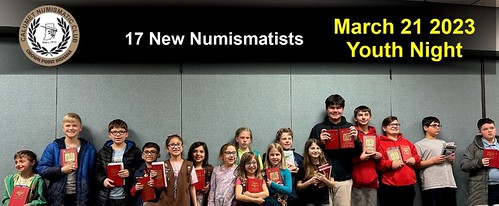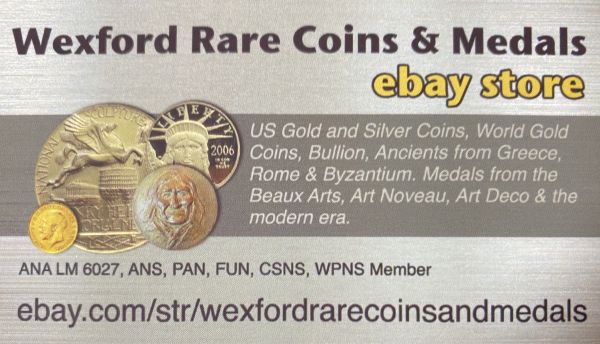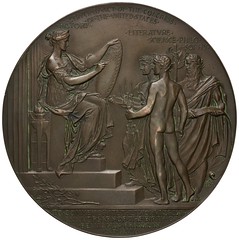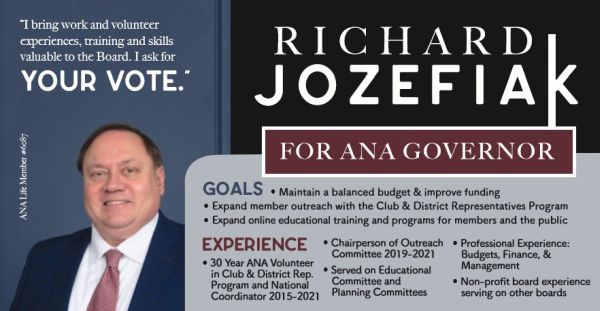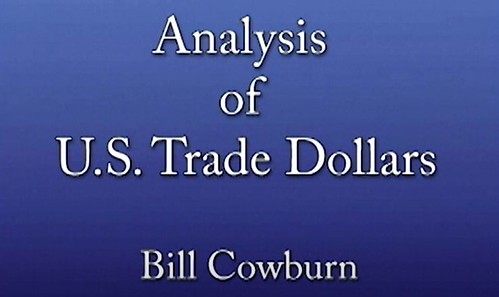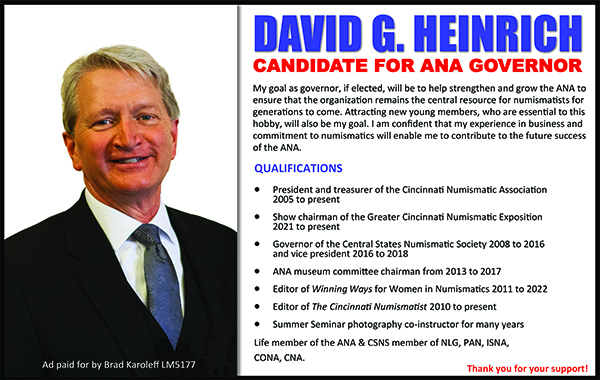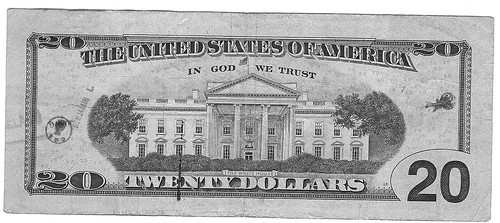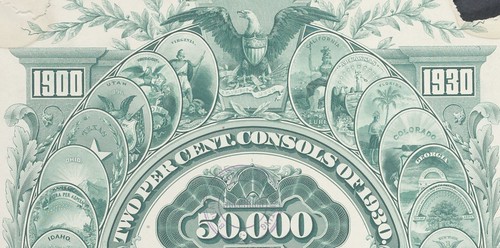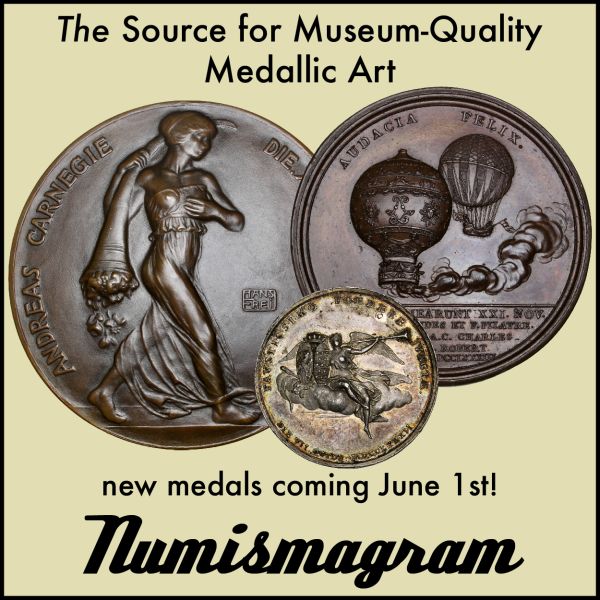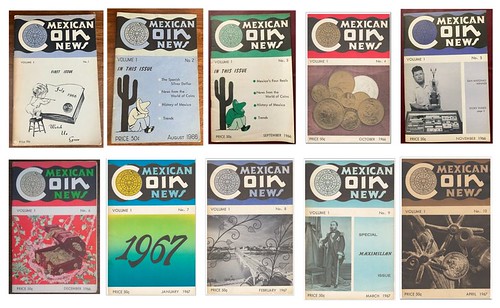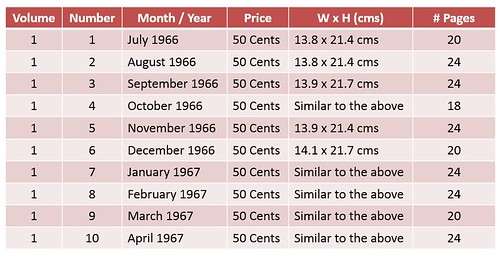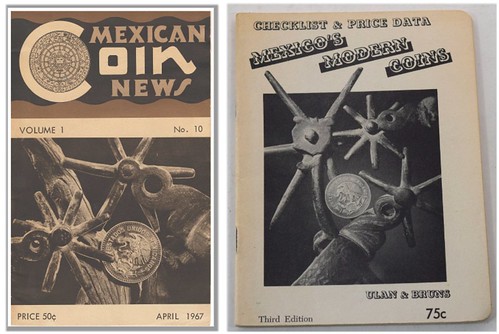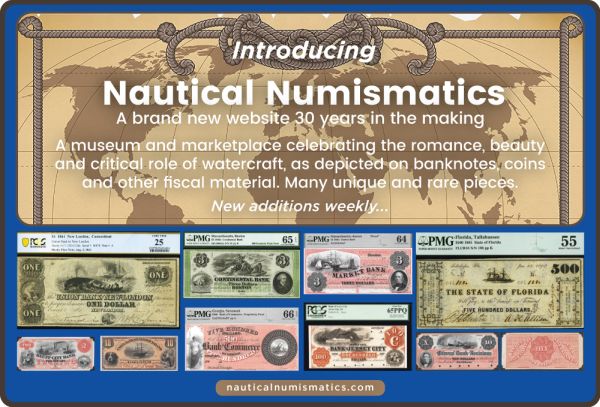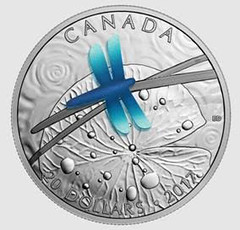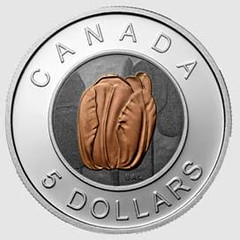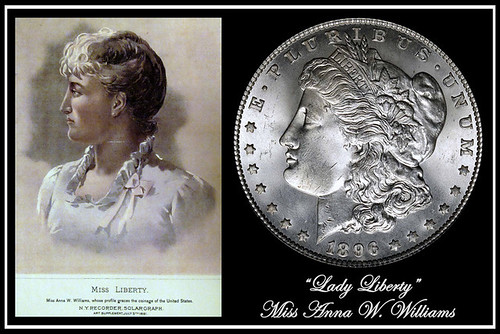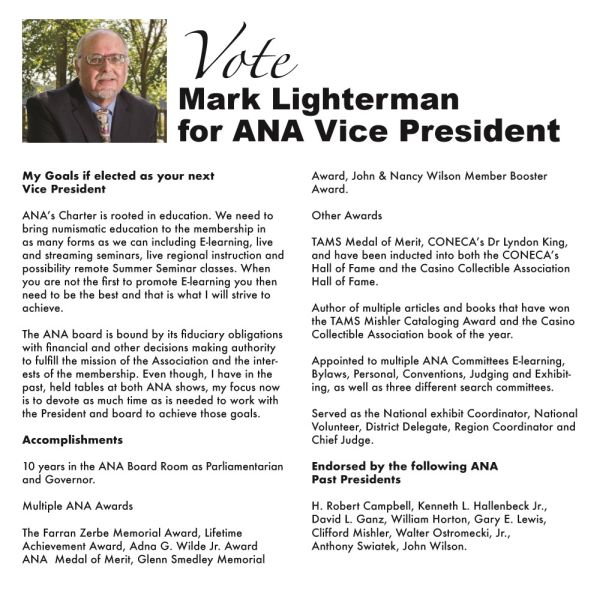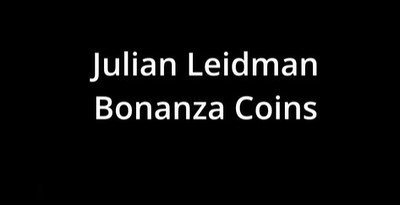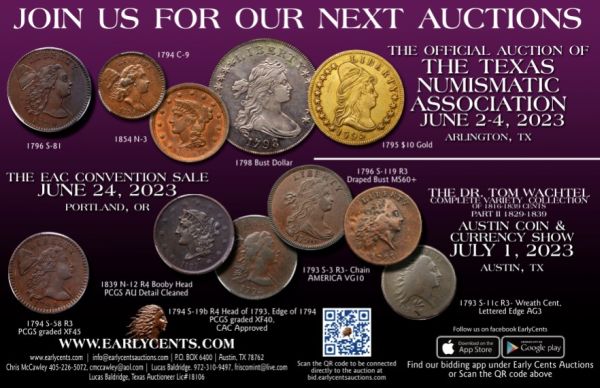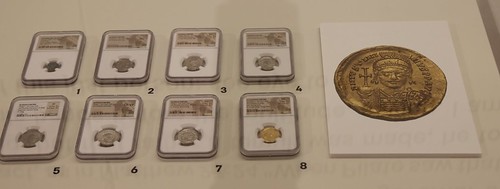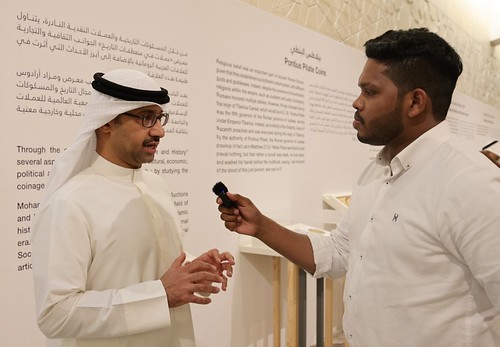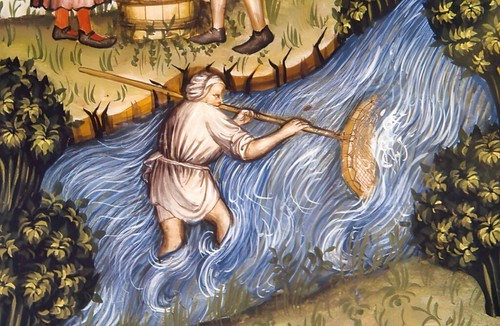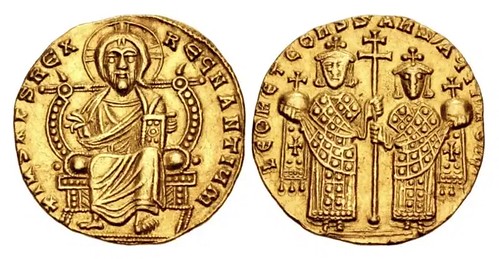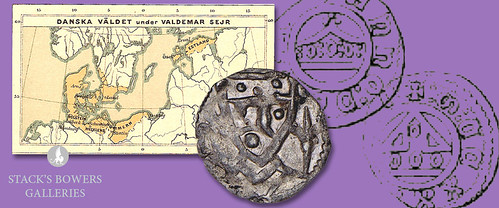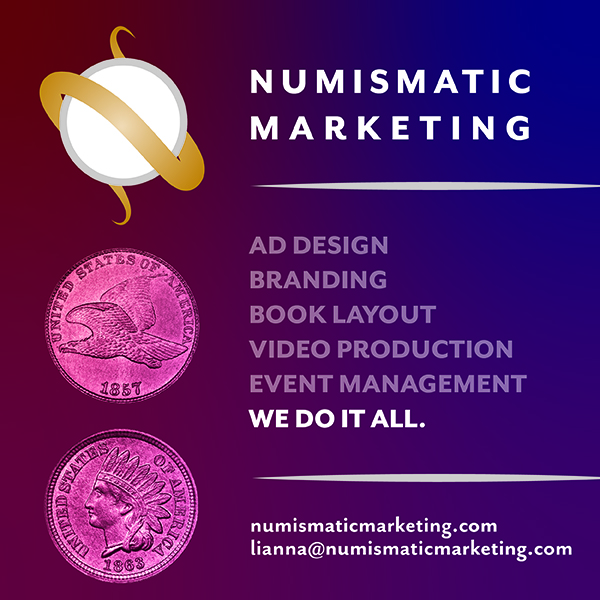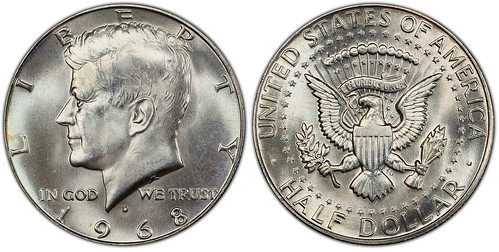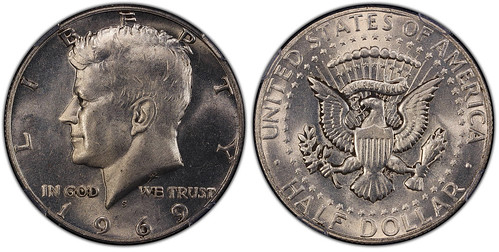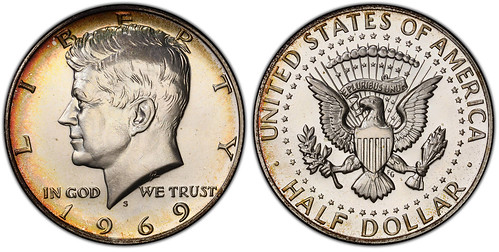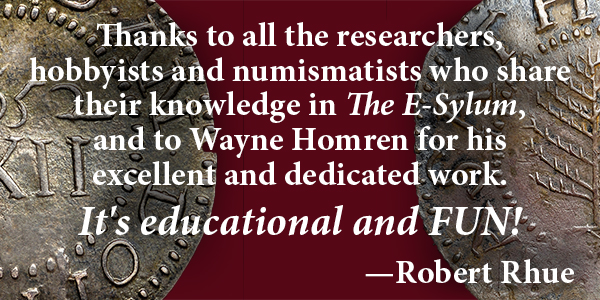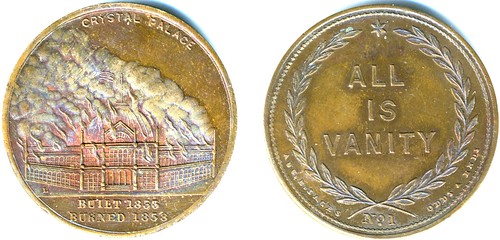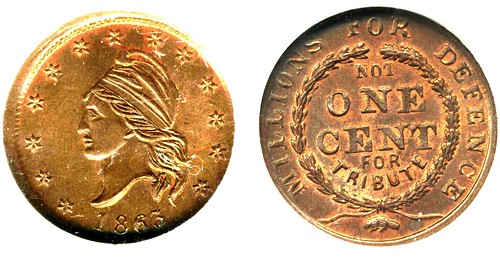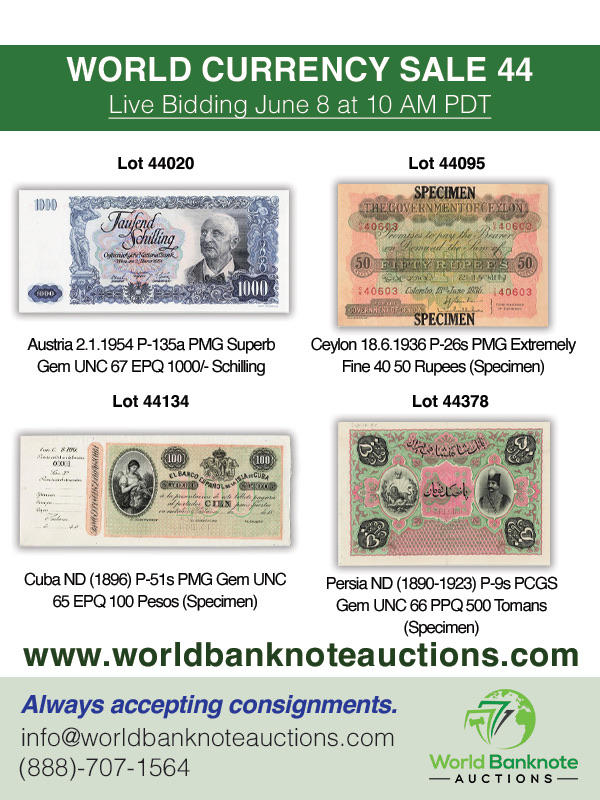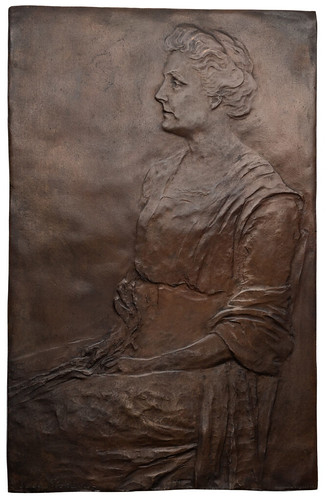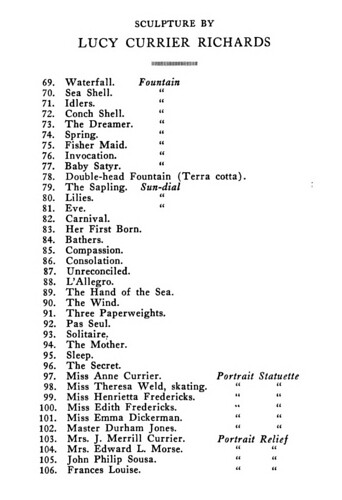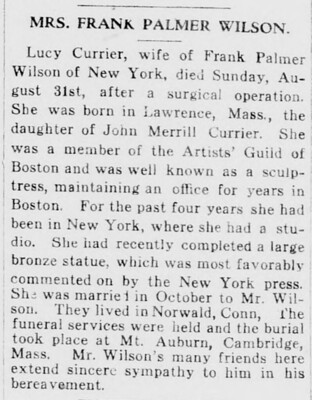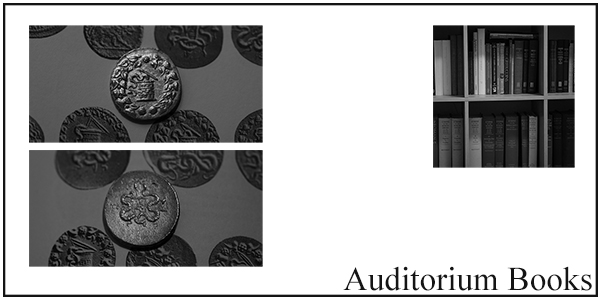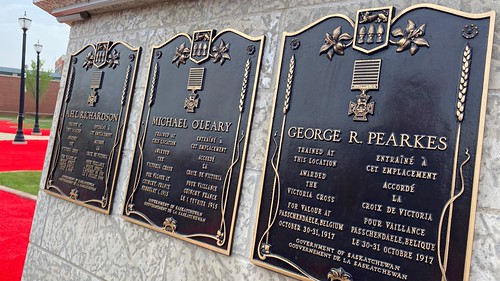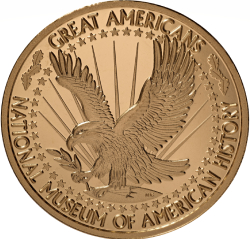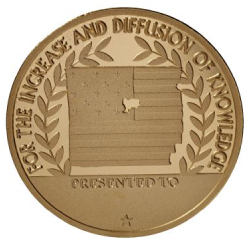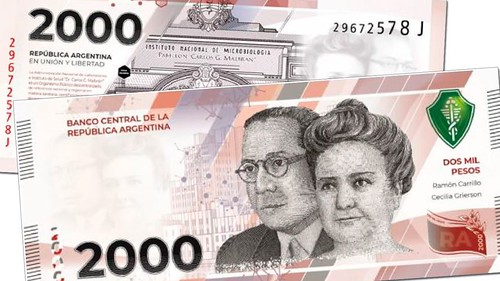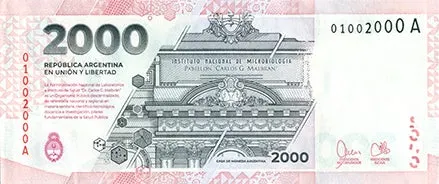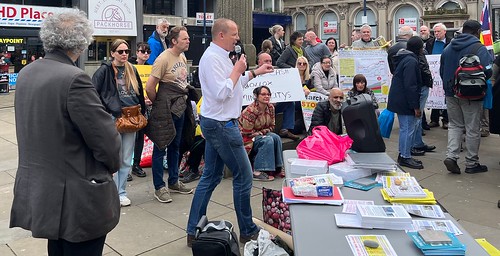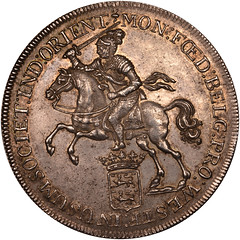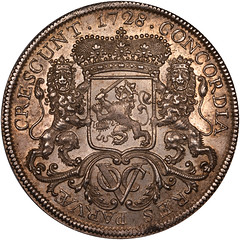
Visit our NBS Sponsors




About UsThe Numismatic Bibliomania Society is a non-profit association devoted to the study and enjoyment of numismatic literature. For more information please see our web site at coinbooks.org SubscriptionsThose wishing to become new E-Sylum subscribers (or wishing to Unsubscribe) can go to the following web page link MembershipThere is a membership application available on the web site Membership Application To join, print the application and return it with your check to the address printed on the application. Print/Digital membership is $40 to addresses in the U.S., and $60 elsewhere. A digital-only membership is available for $25. For those without web access, write to: Charles Heck, Treasurer AsylumFor Asylum mailing address changes and other membership questions, contact Chuck at this email address: treasurer@coinbooks.org SubmissionsTo submit items for publication in The E-Sylum, write to the Editor at this address: whomren@gmail.com BUY THE BOOK BEFORE THE COINSale Calendar |
- WAYNE'S WORDS: THE E-SYLUM MAY 28, 2023
- KOLBE & FANNING JUNE 10, 2023 SALE HIGHLIGHTS
- MORE STEVE TANENBAUM LIBRARY SALES
- NEW BOOK: GUIDE BOOK OF LIBERTY SEATED, 2ND ED.
- NEW BOOK: CHEMICOGRAPH BACKS REVISITED, 2ND ED.
- 2023 SHEKEL PRIZE ANNOUNCED
- HOLLIS BURT PINCOCK (1951-2023)
- JEFFREY R. PAUNICKA (1954-2023)
- THE FRANKLIN COMMEMORATIVE MEDAL
- NEWMAN GRANTS 2023 AWARD ANNOUNCEMENT
- VIDEO: U.S. TRADE DOLLARS
- MORE ON THE FADING OF DIGITAL IMAGES
- MORE ON MEXICAN COIN NEWS
- NOTES FROM E-SYLUM READERS: MAY 28, 2023
- VOCABULARY TERMS: MONOGRAM FILLER, MORTUARY MEDAL, MOUNTING
- LEONARD S. FORRER (1869-1953)
- JULIAN LEIDMAN INTERVIEW, PART FOUR
- JULIAN LEIDMAN INTERVIEW, PART FIVE
- RICHARD LOBEL INTERVIEW PART THREE
- RICHARD LOBEL INTERVIEW PART FOUR
- BAHRAIN NATIONAL MUSEUM COIN EXHIBIT
- PAYING RENT WITH EELS IN MEDIEVAL ENGLAND
- THE COINAGE OF CONSTANTINE
- FIRST COMMON ERA DATE ON A COIN IS 1234
- COUNTERFEIT KENNEDY HALF DOLLARS
- DAVE BOWERS ON AMERICAN MEDALS
- LUCY CURRIER RICHARDS, SCULPTOR
- MONUMENT FOR CANADIAN VICTORIA CROSS WINNERS
- GREAT AMERICANS MEDAL AWARDED TO YO-YO MA
- ARGENTINA INTRODUCES 2,000-PESO NOTE
- DIEHARDS PROTEST CASH DISAPPEARANCE
- CHINESE TEAPOT WITH DUTCH COIN TOUCH
Click here to read the thin version on the web
Click here to subscribe
Click here to access the complete archive
To comment or submit articles, reply to whomren@gmail.com
Content presented in The E-Sylum is not necessarily researched or independently fact-checked, and views expressed do not necessarily represent those of the Numismatic Bibliomania Society.
WAYNE'S WORDS: THE E-SYLUM MAY 28, 2023
 New subscribers this week include:
Joe Wobblie,
and Anya M.
Welcome aboard!
New subscribers this week include:
Joe Wobblie,
and Anya M.
Welcome aboard!
Thank you for reading The E-Sylum. If you enjoy it, please send me the email addresses of friends you think may enjoy it as well and I'll send them a subscription. Contact me at whomren@gmail.com anytime regarding your subscription, or questions, comments or suggestions about our content.
This week we open with two numismatic literature sales, two new books, the Shekel Prize, two obituaries, updates from the Newman Numismatic Portal, and more.
Other topics this week include Liberty Seated coinage, the Franklin Commemorative medal, the 2023 Newman Grants, Mexican Coin News, the coinage of Constantine, sculptor Lucy Richards, Leonard S. Forrer, the Great Americans medal, and mortuary medals.
To learn more about Hodges's 1862 American Bank Note Safe-Guard, the Waldo C. Newcomer collection, plantation tokens of Puerto Rico, Play Money, the Confederate Chemicograph Backs, the Lord and Lady Baltimore medal, U.S. Trade Dollars, Canada's niobium coins, a hoard of 17 million British military notes, the Bahrain National Museum exhibit, money disappearance protesters, and paying rent with eels, , read on. Have a great week, everyone!
Wayne Homren
Editor, The E-Sylum
KOLBE & FANNING JUNE 10, 2023 SALE HIGHLIGHTS
Here are some more highlights in the upcoming June 10. 2023 Kolbe & Fanning numismatic literature sale. -Editor
On Saturday, June 10, 2023, Kolbe & Fanning Numismatic Booksellers will be conducting our next auction sale. Sale 167 includes rare and out-of-print works on coins, medals, and paper money from antiquity to the present, and includes important offerings from the libraries of Louis E. Eliasberg, Sr., and Richard A. Eliasberg, among other properties.
Some highlights of the sale include:
Lot 4: a complete set of Numismatic Notes and Monographs, the long-running ANS series, from 1920 to 1996
Lot 40: Christian Giel's rare 1886 work on ancient coins of the Black Sea region
Lot 94: the complete Roman Imperial Coinage, entirely up to date
Lot 139: Brasseaux's very rare catalogue of Napoleonic medals, as issued in the original paper-covered installments
Lot 202: Fernand Mazerolle's classic 1902–1904 study of French medallists, complete in three volumes
Lot 210: José Toribio Medina's rare and important 1919 work on Admiral Vernon medals, in the original printed card covers
Lot 254: the 1730 London edition of Swift's collected Drapier's Letters against the coinage of William Wood for Ireland
Lot 300: Louis Eliasberg's plated copy of the extraordinary John Story Jenks catalogue, issued by Henry Chapman in 1921
Lot 340: an exceptionally well-preserved copy of Edward Hodges's 1862 American Bank Note Safe-Guard
Lot 384: an original copy of Waldo C. Newcomer's typewritten inventory of his United States coin collection, ex Louis Eliasberg, a record of one of the greatest collections of U.S. coins never to have been properly catalogued, of enormous importance for provenance research.
Register early to bid online
Bids may be placed via post, email, fax or phone, as well as online. Kolbe & Fanning use Auction Mobility as our third-party online bidding platform. Auction Mobility is an app-based platform allowing users the ability to participate in the sale through phones, tablets and computers. To register for the sale, bidders must go to
bid.numislit.com and sign up. Once you have set up an account, you may browse lots, place advance bids, or participate in the live sale online. Those wishing to participate on their devices can download the Kolbe & Fanning app through the Apple or Google Play Store. The sale has also been listed on Biddr and NumisBids.
The printed catalogue has been mailed to all active customers on our mailing list. As international mail speeds have been inconsistent, we encourage our foreign clients to consult the electronic catalogue in case their printed catalogue does not arrive promptly. A PDF of the printed catalogue has been posted to our main website at numislit.com for those who prefer that format. Bids placed via post, email, fax or phone must be received by June 9, the day before the sale, in order for them to be processed. Advance absentee bids may also be placed at any time online at bid.numislit.com. Live internet bidding will be available during the sale itself through the same platform.
Kolbe & Fanning Numismatic Booksellers LLC is a licensed and bonded auction firm in the State of Ohio, and our sales are conducted by licensed auctioneers. For more information, please see the Kolbe & Fanning website at numislit.com or email David Fanning at df@numislit.com. To register for the sale, go to bid.numislit.com. We look forward to your participation.
To view the Catalogue PDF, see:
https://numislit.cdn.bibliopolis.com/images/upload/kolbefanningsale167.pdf
To read the earlier E-Sylum article, see:
KOLBE & FANNING JUNE 10, 2023 SALE
(https://www.coinbooks.org/v26/esylum_v26n21a02.html)
MORE STEVE TANENBAUM LIBRARY SALES
Steve Hayden has been handling the dispersal of the numismatic library for the estate of token dealer Steve Tanenbaum. Several new lots are available for bidding on eBay under his seller ID "stevehayden". Here are some selected items. In an email to clients this week, Steve H. wrote: "We have also returned to the Tanenbaum Library which we have been selling off and on for the last four years. For the rest of the summer look for many interesting books, auction catalogs and odd and ends from this extensive collection both at fixed price and auction." -Editor
To view Steve's book offerings, see:
https://www.ebay.com/str/stevehayden/Books/_i.html?store_cat=24750883014
NEW BOOK: GUIDE BOOK OF LIBERTY SEATED, 2ND ED.
Whitman has released a new edition of the Liberty Seated guide book. Here's the announcement. -Editor
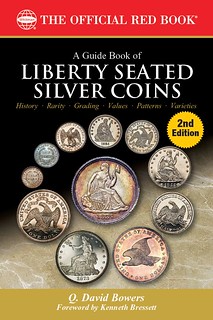 Whitman Publishing announces the upcoming release of the second edition of A Guide Book of Liberty Seated Silver Coins, by Q. David Bowers. The 608-page book will debut at the American Numismatic Association World's Fair of Money in Pittsburgh, August 8, 2023. Before then it can be preordered online (including at www.Whitman.com) and after the show it will be available from booksellers and hobby shops nationwide, for $29.95.
Whitman Publishing announces the upcoming release of the second edition of A Guide Book of Liberty Seated Silver Coins, by Q. David Bowers. The 608-page book will debut at the American Numismatic Association World's Fair of Money in Pittsburgh, August 8, 2023. Before then it can be preordered online (including at www.Whitman.com) and after the show it will be available from booksellers and hobby shops nationwide, for $29.95.
The United States minted coins with the Liberty Seated design from 1836 to 1891. The motif was used on circulating half dimes, dimes, quarters, half dollars, and silver dollars, in addition to twenty-cent pieces, Gobrecht dollars, and, in modified form, U.S. trade dollars. Tens of millions of the coins were produced at the mints in Philadelphia, New Orleans, Carson City, and San Francisco. They were made from the Hard Times Era through the nation's gold and silver rushes, the Civil War and its aftermath, and well into America's Gilded Age.
As collectibles, Liberty Seated coins have been growing in popularity for years, with many enthusiastic collectors and students. The Liberty Seated Collectors Club (www.lsccweb.org) is among the hobby's fastest-growing specialty groups. Leonard Augsburger, president of the club, who wrote the foreword to the first edition, stated that Q. David Bowers offers both beginning and experienced numismatists a fresh perspective on collecting these fascinating silver coins.
Bowers gives colorful historical context for the coins, describing the American scene (and the state of the coin-collecting hobby) from 1836 to 1891. Then he covers all eight coins that carried the Liberty Seated design, with a coin-by-coin catalog of more than 750 entries. These entries include mintages, auction records, and grade-by-grade market values for every coin. Bowers discusses grading standards, offers advice for building high-quality collections, and explores other factors important to collectors and investors. He describes each coin's availability in Mint State and in circulated grades; characteristics of striking; pattern coins for each denomination; production, release, and distribution; branch-mint coinage; Proofs; die varieties; shipwreck finds; conservation; and more. The book is illustrated with more than 1,500 images.
Appendices include a chronology of coin designer Christian Gobrecht; an overview of the mints used to strike Liberty Seated coins; Mint directors and superintendents of the era; an account of a visit to the Philadelphia Mint in 1861; chief coiner Franklin Peale's description of die making in 1855; a study of master dies and hubs by professional numismatist John Dannreuther; a look at alternative U.S. currency formats of the 1800s (Postage Currency, Standard Silver, and goloid dollars); and a catalog of die and hub trials and splashers, based on the work of Saul Teichman.
Kenneth Bressett, editor emeritus of the Guide Book of United States Coins, has said, Reading a Q. David Bowers book will expand your knowledge and inspire you to broaden and deepen your own studies.
Numismatist Rich Hundertmark, in the E-Gobrecht newsletter, wrote: One of the challenges [of the Liberty Seated Collectors Club] is to attract and maintain its membership and pass down the learnings of experienced collectors to those new to Liberty Seated coinage. In this regard, I see great value in this book as a tool that can be used by collectors of all levels, both new and advanced. . . . The book's photography and images are generally outstanding, and a few renderings of Liberty Seated imagery that I had not previously viewed include a Liberty oil-on-cardboard design that I found quite compelling.
Because Whitman Publishing is the Official Supplier of the American Numismatic Association, ANA members receive 10% off the book when purchasing directly from the publisher. It can also be borrowed for free as a benefit of ANA membership, through the Dwight N. Manley Numismatic Library.
A Guide Book of Liberty Seated Silver Coins, second edition
By Q. David Bowers; foreword by Kenneth Bressett
ISBN 0794850510
6 x 9 inches, softcover, 608 pages, full color
Retail $29.95 U.S.
NEW BOOK: CHEMICOGRAPH BACKS REVISITED, 2ND ED.
Author Peter Bertram has published a new edition of his work on the Confederate Chemicograph Back banknotes. Congratulations. Here's the announcement. -Editor
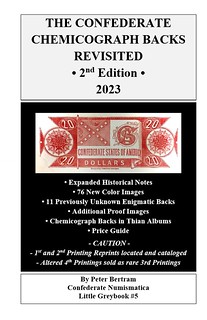 Greetings friends - welcome to another release in my Confederate Numismatica
series of books. I've been fortunate in my data search and have located a good bit of
specialized information and several previously unknown Chemicograph specimens. I
therefore felt that an update to my original Chemicograph Backs article (2018 -
Supplement One) was called for and offer this Second Edition to fulfill the need. It is, to
the best of my knowledge, the only published work on the Confederate Chemicograph
Backs in print and thus fills another void in the study of Confederate Numismatica. I
hope you'll like it!
Greetings friends - welcome to another release in my Confederate Numismatica
series of books. I've been fortunate in my data search and have located a good bit of
specialized information and several previously unknown Chemicograph specimens. I
therefore felt that an update to my original Chemicograph Backs article (2018 -
Supplement One) was called for and offer this Second Edition to fulfill the need. It is, to
the best of my knowledge, the only published work on the Confederate Chemicograph
Backs in print and thus fills another void in the study of Confederate Numismatica. I
hope you'll like it!
These unused Confederate 1864 Treasury note backs have been around for about 145 years but have never really received much press. What do you think - time for another look? OK then, here's a few introductory comments so we can all start on the same page. The intent of the Act of February 17, 1864 was to reduce the volume of currency then in circulation by taxing out of existence all earlier notes not funded into bonds by April 1. But since the fronts of the 1864 notes would be so similar to those of 1863, new reverse plates would be needed and were ordered from S. Straker & Sons of London, England. Straker used the trade name Chemicograph for the process they employed to produce the plates for the $500 to $5 notes.
By early 1864 the 684 plates (28-$500, 51-$100, 80-$50, 125-$20, 200-$10, and 200-$5) were finished and sent in three shipments (Jan 8, Feb 26, and Mar 15) from England to Nassau where they were transferred to blockade runners for the run into Wilmington, NC. But by this time less than half of the blockade runners got through and all three shipments vanished after leaving Nassau. Their probable fate was to have been seized by a Union warship and later consigned to a melting pot as scrap. So the Chemicograph story could very well have ended right here but for a Mr. Charles Chaplin (not the old movie's Charlie Chaplin!) who discovered and rescued six of the plates! To announce his discovery Chaplin sent prints from his plates to the American Journal of Numismatics and they published them in 1877 and 1878 (pg. 6-7). These were the first public notification of the survival of any of the printing plates! So, that's a highly abbreviated account of the Chemicograph background. and brings us up to about 1878.
The Chemicograph backs story includes Raphael Thian, David Proskey, Lyman H. Low, F.C.C. Boyd, Philip Chase, Dartmouth College, Duke University, and numismatic literature and ephemera. The book is excellently researched and illustrated, and well suited for the library of anyone interested in U.S. paper money, Confederate and Civil War numismatics, and the history of the numismatic hobby and literature. -Editor
Note also:
- This is the only published, complete study of these unused 1864 Confederate Treasury Note reverses.
- The altering of 4th Printing Type 1 Backs to make them appear to be 3rd Printing Backs (pg 40-41 : to appreciate the price difference, see Price Guide p107).
- The convenience of the "Quick Reference" pages 108-109.
For more information, or to order, see:
THE CONFEDERATE CHEMICOGRAPH BACKS REVISITED
(https://www.amazon.com/CONFEDERATE-CHEMICOGRAPH-BACKS-REVISITED/dp/B0C5Z3FJVZ/ref=sr_1_1)
To read the earlier E-Sylum article, see:
NEW BOOK: CONFEDERATE NUMISMATICA SUPPLEMENT ONE
(https://www.coinbooks.org/v21/esylum_v21n32a05.html)
2023 SHEKEL PRIZE ANNOUNCED
2023 Shekel Prize has been announced - here's the press release. Congratulations! -Editor
Mel Wacks, chair of the American Israel Numismatic Association's Shekel Prize Committee, has announced that the unanimous choice of the jurors for the 2023 Shekel Prize are Dr. Yitzhak Magen, Dr. Gabriela Bijovsky and Yoav Tzionit for the book Mount Gerizim Excavations - The Coins. The Shekel Prize is awarded annually to the best book published on the topic of ancient Judaean coins, coins of the Holy Land or Judaic numismatics. The winning volume discusses the History of the Samaritans on Mount Gerizim and includes the corpus of coins discovered on the site dating between the Persian and Byzantine Periods.
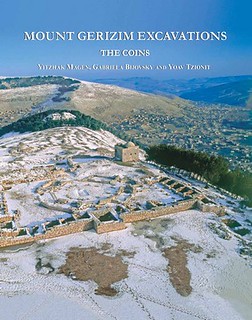 The first section, written by Dr. Yizhak Magen, Head Archaeological Officer for the Civil Administration of Judea and Samaria, details the history of the Samaritans and Mt. Gerizim from the destruction of Samaria at the end of the eighth century BCE until the Byzantine period. The author discusses coins discovered at Mt. Gerizim that have helped put to rest more than a century of historical and archeological debate over research issues regarding the Samaritans. The second section, by Dr. Gabriela Bijovsky, analyzes the thousands of coins discovered at Mt. Gerizim dating from the Persian period to the Byzantine period. The author deals with several aspects of the Mt. Gerizim coins, among them chronology, typology and the study of mints. The third section was prepared by Yoav Tzionit, Senior Curator for the Archaeology Department of the Civil Administration of Judea and Samaria, and includes the database of the coins from Mt. Gerizim.
The first section, written by Dr. Yizhak Magen, Head Archaeological Officer for the Civil Administration of Judea and Samaria, details the history of the Samaritans and Mt. Gerizim from the destruction of Samaria at the end of the eighth century BCE until the Byzantine period. The author discusses coins discovered at Mt. Gerizim that have helped put to rest more than a century of historical and archeological debate over research issues regarding the Samaritans. The second section, by Dr. Gabriela Bijovsky, analyzes the thousands of coins discovered at Mt. Gerizim dating from the Persian period to the Byzantine period. The author deals with several aspects of the Mt. Gerizim coins, among them chronology, typology and the study of mints. The third section was prepared by Yoav Tzionit, Senior Curator for the Archaeology Department of the Civil Administration of Judea and Samaria, and includes the database of the coins from Mt. Gerizim.
Shekel Prize medals will be presented to Dr. Yitzhak Magen, Dr. Gabriela Bijovsky and Yoav Tzionit later this year by Dr. Haim Gitler, one of the jurors and Chief Curator of Archaeology and Curator of Numismatics at The Israel Museum, Jerusalem. Mount Gerizim - The Coins can be purchased from the Israel Antiquities Authority (www.antiquities.org.il/), and can be read free at www.academia.edu.
The other candidates for the Shekel Prize were Forging Secrets: Faces and Facts Inside the Nazi Operation Bernhard Scheme edited by Kiel Majewski, Joseph Boling and Daniel Spungen; Who's Who in the Jewish-American Hall of Fame by Mel Wacks; 2022-23 Guide Book Coins, Banknotes and Tokens of Israel by Israel Asher; and Israel Numismatic Research 17/2022 edited by Donald Ariel and Danny Syon.
The American Israel Numismatic Association (www.theshekel.org) publishes The Shekel, The Journal of Israel and Jewish History and Numismatics; memberships are available for $18 (digital) or $40 (printed) by calling 818-225-1348.
HOLLIS BURT PINCOCK (1951-2023)
John Mutch passed along this interesting obituary of coin dealer and Idaho token book author Hollis Pincock. -Editor
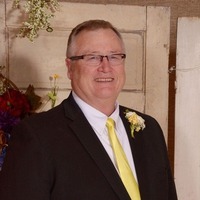 Hollis Burt Pincock, Jr., age 71, of Burley, Idaho, passed away surrounded by family on May 16, 2023.
Hollis Burt Pincock, Jr., age 71, of Burley, Idaho, passed away surrounded by family on May 16, 2023.
Hollis was the oldest of seven children born August 23, 1951, in Huntington Park, California to Suzanne Sanders and Hollis Pincock, Sr.
Hollis' parents learned early on that he had a musical gift. When he was 5 years old, he heard a piano performance on the Lawrence Welk show and immediately got up and played it on the family piano. He could play almost anything by ear and soon learned to read music. He could play 3 instruments by age 9 and began playing professionally as early as 10 years old in Los Angeles. He was a member of the Huntington Park Youth Band directed by Phil Moore and toured in an adult symphony with top billing. He also performed on the Ed Sullivan Show, with the New Christy Minstrels, Lawrence Welk, and Herb Alpert, to name just a few.
Hollis graduated from Huntington Park High School in 1969. He was a talented athlete and was also the sports editor of the school newspaper.
After high school, Hollis attended BYU where he was an active member of the Cougar Marching Band. In fact, he was the original electric bass player of the BYU Cougar marching band and holds the honor of being the first marching electric bass in the United States, made possible by remote control and radio transmitters and receivers. He was also a member of the Symphonic Band, Philharmonic Orchestra, Wind Ensemble, Jazz Band, Program Bureau, Sounds of Freedom, Young Ambassadors, Lamanite Generation, College Edition, and played intramural sports (football, basketball, volleyball, tennis, golf). During his time with the BYU Singers College Edition,
he toured US Military bases all over the world including Europe, Germany, and Japan. Hollis earned a Bachelor's in Music Education at BYU and a Master's of Education from the University of Idaho.
Hollis served a mission for the Church of Jesus Christ of Latter-Day Saints in Venezuela from 1975-77, where he became fluent in Spanish.
For over 30 years (1979-2011), Hollis taught music in Utah and Idaho: both marching and concert band, jazz band, orchestra, flag corps, theory, music history, drum corps, choir, show choir, elementary music, and guitar. He touched the lives of many students at Boise High School, Timberline High School (where he was the first band teacher of that school), and Carey Schools.
In addition to music and sports, Hollis enjoyed collecting/buying/selling gold, silver, coins (US and World), paper money, tokens, and other collectibles. As the owner of CH Coins, Hollis was well known for selling high-quality coins, giving expert advice/knowledge, and great service for almost 40 years. He was the author of the book "Idaho Tokens for Collectors," THE preeminent source of knowledge on Idaho tokens and their value.
Hollis was active in the Church of Jesus Christ of Latter-Day Saints. One of his favorite callings was as Branch President at the Idaho State Penitentiary. He served as Elders Quorum leader, High Priest Group leader, and taught Gospel Doctrine. He also loved genealogy and writing life histories.
Hollis was married to Janette Booth (1978-1998). They had 5 children together. He later married Camille Judd (1999-2014) and had 4 children together. His children were his greatest source of joy.
To read the complete obituary, see:
Hollis Burt Pincock of Burley, Idaho | 1951 - 2023 | Obituary
(https://www.magicvalleyfuneralhome.com/obituary/hollis-pincock)
JEFFREY R. PAUNICKA (1954-2023)
Christopher Bower submitted these thoughts on collector Jeff Paunicka of Indiana, who passed away recently. Thank you. -Editor
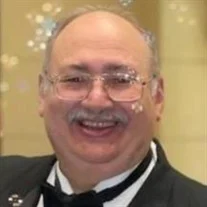 I only knew Jeff a few years and can hardly say that I
I only knew Jeff a few years and can hardly say that I knew
him. In that short time, 5 years or so, it
became evident that he was a true advocate for the hobby and truly loved mentoring young
numismatists.
Jeff was a new member of the board for the Indiana State Numismatic Association, serving as a district Governor for the northern part of the state. It is an area that we have always struggled to cover, and we were looking forward to him bringing his energy to the position. His last email to the board was an update on the Calumet and Goodfellow clubs in northwest Indiana. His report was more thorough than we are used to seeing but it was not surprising coming from Jeff. Below are some pictures that he shared.
If you have ever received an email from Jeff, then you know that he was proud of the clubs that he was a part of. I don't know where he found the energy to support all his associations in addition to being a well-respected dealer as well.
Member:
- Professional Currency Dealers Association - PCDA
- American Numismatic Association - ANA
- Society of Paper Money Collectors - SPMC
- International Bank Note Society - IBNS
- Indiana State Numismatic Association - ISNA - Governor
- Fractional Currency Collectors Board - FCCB
- Chicago Coin Club - CCC
- Illinois Numismatic Association - ILNA - Life Member 257 - Past Governor
- Central States Numismatic Association - CSNA
- Michigan State Numismatic Society - MSNS
- Missouri Numismatic Society - MNS
- Florida United Numismatists - FUN
- Indianapolis Coin Club - ICC
- Calumet Numismatic Club - CNC
- Good Fellow Coin Club - GCC
- Marion Coin Club - MCC
To read Jeff's online obituary, see:
Jeffrey R. Paunicka
(https://www.burnsfuneral.com/obituaries/Jeffrey-Paunicka/#!/Obituary)
THE FRANKLIN COMMEMORATIVE MEDAL
The latest addition to the Newman Numismatic Portal is correspondence from Homer Saint-Gaudens (son of Augustus) about the the Franklin Commemorative Medal. Project Coordinator Len Augsburger provided the following report. -Editor
Homer Saint-Gaudens Speaks on the Franklin Commemorative Medal
Scanning of the American Numismatic Society member correspondence through the 1930s continues apace, with correspondents through the letter S now posted. In a communication of April 22, 1927, Homer Saint-Gaudens (son of Augustus) clarifies the creation of the Tiffany medal commemorating the bicentennial of the birth of Benjamin Franklin. Saint-Gaudens writes in part I do not approve of your showing the medal as being done merely by ‘Saint-Gaudens,' because that is equivalent to saying ‘Augustus Saint-Gaudens,' as far as the general public is concerned.
Homer clarified that the work was done by his uncle Louis, and that my father always considered it the work of his brother.
The Medallic Art Company consulted with the engraver James E. Fraser, who has assisted Augustus Saint-Gaudens with the medal. Fraser credited the reverse to Louis but felt that Augustus had reworked the obverse to the extent that beyond question the portrait was his work.
The whole thread is reminiscent of the authorship of the Beatles' catalog. John and Paul sometimes provided differing stories as to who composed what. The Saint-Gaudens clan was likely not operating under the same level of mind-altering substances, but the salient point is that in a commercial operation with many moving parts, the details of exactly who did what are sometimes lost to history.
Images: Birth of Franklin bicentennial medal, ANS catalog no. 1961.137.4. GM-118 to GM-120.
Link to Homer Saint-Gaudens correspondence with ANS:
https://archive.org/details/saintgaudenshome00amer
Link to ANS member correspondence:
https://archive.org/details/americannumismaticarchival?sort=-publicdate
NEWMAN GRANTS 2023 AWARD ANNOUNCEMENT
Len Augsburger provided this announcement of the 2023 Newman Grants on May 25th, the birthday of the late Eric P. Newman. More great projects outlined here -Editor
Eric P. Newman Numismatic Education Society Announces Newman Grants
 The Eric P. Newman Numismatic Education Society (EPNNES) today announces its fourth set of Newman Grants, created to financially assist numismatic authors and organizations pursuing original research in American numismatics. Newman Grants are awarded annually on the late Eric P. Newman's birthday and assist with direct costs of numismatic research such as travel, photography, and graphic arts services.
The Eric P. Newman Numismatic Education Society (EPNNES) today announces its fourth set of Newman Grants, created to financially assist numismatic authors and organizations pursuing original research in American numismatics. Newman Grants are awarded annually on the late Eric P. Newman's birthday and assist with direct costs of numismatic research such as travel, photography, and graphic arts services.
Five awards are being made this year, touching on varied aspects of numismatics including United States federal coinage, medals, and Spanish-American paper money. The 2023 Newman Grant awardees are:
Benjamin Gastfriend will research elongated pieces produced at the Panama-California and Panama-Pacific International Expositions in the early 20th century, with a focus on archival materials held by the San Diego History Center.
Scott Miller will conduct research on the Lord and Lady Baltimore medal (Betts 34) with the objectives of documenting technical characteristics and creating a definitive census.
Ángel O. Navarro-Zayas has previously published within the field of Spanish-American numismatics and will research the use of 18th century paper money in Puerto Rico, with the goal of uncovering fractional issues possibly issued in the same period.
Shawn Tew will work with U.S. Mint documentation in the National Archives, with the objective of explaining observed anomalies in Lincoln cent production at the beginning of that series.
Winston Zack is well known as a researcher of contemporary counterfeits of early American coinage and will continue that study, concentrating on counterfeit half dollars and silver dollars.
It is the hope of EPNNES that this program will continue the legacy of Eric P. Newman in a way that would reflect his high standards for numismatic research.
VIDEO: U.S. TRADE DOLLARS
The David Lisot Video Library on the Newman Numismatic Portal can be found at:
https://nnp.wustl.edu/library/multimediadetail/522852
We highlight one of his videos each week in The E-Sylum. Here's one from 2007 about U.S. Trade Dollars with collector Bill Cowburn. -Editor
 Numismatist Bill Cowburn is an avid collector and researcher of the U.S. Trade Dollar series. Why was the Trade Dollar created? What are the key dates? What about counterfeits? Viewers will get the answers in this outstanding overview of the U.S. Trade Dollar series. The lecture with slides presentation includes:
Numismatist Bill Cowburn is an avid collector and researcher of the U.S. Trade Dollar series. Why was the Trade Dollar created? What are the key dates? What about counterfeits? Viewers will get the answers in this outstanding overview of the U.S. Trade Dollar series. The lecture with slides presentation includes:
- reasons why the Trade dollar was created in 1873 and the changes that had occurred in America's coinage
- how developing trade in the Orient facilitated production of the Trade dollar
- designer Charles Barber and the symbolism in the design
- weight differences in the different silver dollar-sized coins
- why production of Trade dollars ceased in 1877
- examples of the types and many varieties and how to identify them
- the different stages of legal status for this coin
Speaker(s): Bill Cowburn.
To watch the complete video, see:
https://nnp.wustl.edu/library/book/560270
MORE ON THE FADING OF DIGITAL IMAGES
Peter Huntoon submitted these further comments on the fading of digital images. -Editor
I have read with great interest the comments that have been submitted on this topic over the past few weeks. Most have been technically oriented with explanations, rationalizations and speculations on how fading can or cannot occur, with targets for how it can occur being (1) repeated image manipulation and (2) limitations of different file storage formats. The widely used JPG and JPEG compressed file formats have received most of the attention and rightly so because they are heavily used in archival work because of space considerations.
The implication from these comments is that fading does in fact occur; however, virtually missing for our dialog so far is actual acknowledgment that anyone is willing to admit that they have observed fading other than my own blunt statement at the outset that the digital images I have saved are unambiguously fading and the degree of fading is a function of age. My oldest images are about 30 years old.
I simply ask you again the number one question. Have any of you noticed that digital images you have saved have faded?
This is a yes or no question. If you have, let us know.
I met this past week with Peter Runga, the administrator of Special Collections at the Cline Library at Northern Arizona University in Flagstaff. Special collections is a major repository for rare books, historic documents, photographs, etc. and that unit as well as the Cline Library itself are up to their necks in digitization and digital storage. I asked him about their experience. He groaned and said fading was a major problem. Like me, he is not a techie, but a user. Our anecdotal experiences were identical, but of course the breath and depth of his experience far outweighs mine. Sobering was this exchange.
Huntoon's off the cuff remark: At the rate my images are deteriorating, they will be gone in a
100 years.
Runga, turning sharply and looking me straight in the eyes: 50 years.
We then discussed his observation and these perspectives emerged.
(1) fading of digital image is real and is of major concern among archivists.
(2) Fading is dependent on shelf life
– that is how long the image has been stored in a particular
storage device regardless of image format.
(3) Modern computers can copy stored images with a high degree of fidelity so information loss is not a big issue when image data are repeatedly moved between servers or lifted by users from such storage because computers can check the copy against the original. However, what gets copied and checked is what remains of the original in storage at the moment it is copied.
I've not noticed fading of digital images, although I don't have a photo archive outside of The E-Sylum. We use Flickr as our hosting service and began loading images in February, 2008. Our first issue using images was published on May 18, 2008. I went back to look at some of our earlier images.
The first image in our archive is of a gold coin that was uploaded on February 29, 2008 - about 15 years ago. It looks fine.
The first image of paper money was an image of a chopmarked note submitted by Howard Daniel. It looks odd (is it black and white?), but I don't remember if it arrived that way or not.
Below is a .jpg photo Peter retrieved from the Smithsonian BEP archive. He says the file had not been opened, edited or moved in years. I would agree that it looks washed out.
So back to Peter's question: Have any of you noticed that digital images you have saved seem faded? -Editor
To read the earlier E-Sylum article, see:
ON THE FADING OF DIGITAL IMAGES
(https://www.coinbooks.org/v26/esylum_v26n19a11.html)
READERS ON THE FADING OF DIGITAL IMAGES
(https://www.coinbooks.org/v26/esylum_v26n20a09.html)
MORE ON MEXICAN COIN NEWS
Regarding the inquiry from Adrian Gonzalez Salinas about the 1960's publication Mexican Coin News, Allan Schein writes:
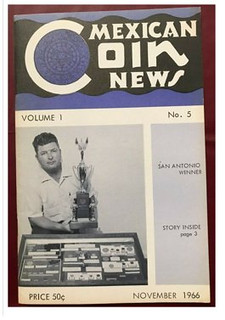 "I am aware of 10 issues and these were recently scanned for the US Mexican Numismatic Association. Issues #1 thru #3 we only have photocopies of, but #4 thru #10 are originals. These came from the estate of longtime Mexican coin & currency dealer Ken Tabachnick who passed away in August of 2022.
"I am aware of 10 issues and these were recently scanned for the US Mexican Numismatic Association. Issues #1 thru #3 we only have photocopies of, but #4 thru #10 are originals. These came from the estate of longtime Mexican coin & currency dealer Ken Tabachnick who passed away in August of 2022.
"Please give Adrian my contact info. If we can scan his first three issues, the USMEX will be able to preserve a complete digital set all scanned from originals. And the club will be happy to help Adrian to complete his set by giving him theirs. After all, we have the same interests and are part of the same collecting community."
I put Allan in touch with Adrian, who writes:
"Now I know that there are just 10 different Mexican Coin News (MCN) magazines. In fact, in the MCN #10 appears a notice that it was the final issue including the causes why they did not continue publishing it. I am a member of the U.S. Mexican Numismatic Association so I could download the 5 MCN issues that I don't have. I will contact Allan Schein to thank him for his support and how I can share a scanning of the MCN 1, 2 and 3 issues. It's amazing how E-Sylum readers can help you."
Allan adds:
"Adrian did contact me and we'll share what we have. My thanks to you for facilitating contact. It's a great example of how much of our community interfaces through The E-Sylum. I appreciate the invaluable resource you've created and dedicated yourself to in such an enduring manner."
We're all glad to help, and love happy endings like these. Adrian provided additional information and updated images for this article. -Editor
Adrian writes:
"Frankly, it is so nice to have the support of the whole The E-Sylum community. In less than 24 hours, Ralf Böpple (Stuttgart, Baden-Württemberg, Germany) and Allan Schein (Salt Lake City, Utah) shared with me super valuable information about Mexican Coin News issues! I am very grateful to them!
"According to H. R. Vrooman (editor of MCN),the root cause why MCN has not continuing to be published: "We have have not had the support of the advertisers that we were promised when we started, publication. To make a long story short, most of the dealers who made us the promise have either quit advertising and several have quit the business entirely. Some who did advertise did not pay. With the high cost of paper and labor, today, it takes a lot of dinero (money) to keep a magazine of any kind in publication. Mexican Coin News was never backed by any organization or group. It has been a father-son team, hoping in some small way to be of service to the collectors and dealer (sic) in Mexican Coins and Currency".
"Pictures of issues covers # 4, 7, 8, 9 and 10 are from the US Mexican Numismatic Association Digital Library (usmex.org). If you are a collector of Mexican coins, notes, medals, tokens, bonds, etc. I recommend you to be a member of this association.
"The cover's picture of the latest MCN's issue (# 10) is similar to the booklet "Checklist and Price Data / Mexico's Modern Coins" by H.S. Ulan and Harvey Bruns (Third edition; 1967; 36p; 16mo; Softcover)."
To read the earlier E-Sylum article, see:
QUERY: MEXICAN COIN NEWS
(https://www.coinbooks.org/v26/esylum_v26n21a12.html)
NOTES FROM E-SYLUM READERS: MAY 28, 2023
A Bonanza Coins Bonus
Joe Wobblie writes:
"The interview with Julian Leidman reminds me of a little story of my own.
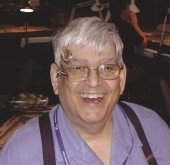 "About 20 years ago I was in Washington DC on a business trip. I was lucky to have some old friends put me up at their Silver Spring, Maryland home. Between their house and the Metro I noticed Bonanza Coins and found a few hours to stop by. I had a great time going through a decent bit of foreign coins. Where I am from, near the West Virginia - Kentucky border, there is not much interest or inventory of foreign coins around, so this was a treat. I had pulled out a nice little pile but when we added it all up I just didn't have the cash on me and no banks nearby where I could get any. "No problem" said Julian, "Just send me a check."
"About 20 years ago I was in Washington DC on a business trip. I was lucky to have some old friends put me up at their Silver Spring, Maryland home. Between their house and the Metro I noticed Bonanza Coins and found a few hours to stop by. I had a great time going through a decent bit of foreign coins. Where I am from, near the West Virginia - Kentucky border, there is not much interest or inventory of foreign coins around, so this was a treat. I had pulled out a nice little pile but when we added it all up I just didn't have the cash on me and no banks nearby where I could get any. "No problem" said Julian, "Just send me a check."
"I was a bit stunned - here I am a stranger who just walked into the shop and he sent me home with about $150 worth of coins unpaid for. Of course I sent a check as soon as I got home but I will never forget the guy for his kindness and trust."
To read the earlier E-Sylum articles, see:
JULIAN LEIDMAN INTERVIEW, PART TWO
(https://www.coinbooks.org/v26/esylum_v26n21a19.html)
JULIAN LEIDMAN INTERVIEW, PART THREE
(https://www.coinbooks.org/v26/esylum_v26n21a20.html)
Paget Plasters Restrikes
Martin Purdy writes:
"I very much enjoyed the linked video interview with Richard Lobel in the latest E-Sylum. One thing that jumped out at me - at around 42:15 he mentioned a "New Zealand George VI dollar" which he had restruck. Now there weren't any George VI "dollars" here, so the nearest contender would be the 1949 silver crown. This isn't at all rare and I have no knowledge of any private restrikes ever being made. Could that have been a slip for one of the 1936/37 Edward VIII fantasy crowns with the NZ reverse, at least one version of which I believe is on the list of items he's produced over the years?
"He mentions George VI again at 43:15 when he talks about marketing the NZ items through M.R. Roberts in Sydney. It would be good to have this clarified if possible."
Richard Lobel writes:
 "The answer is that years and years ago I bought five plasters done by Humphrey Paget at a Christes auction. I kept them for years, and when Tower Mint was slow on business and short on money I had them make dies and strike them for me. New Zealand, Prince Philip pattern 25p (see Noonans auction 7-8 June 2023 Lot 501), East Caribbean and two South American countries. Most are listed in Unusual World Coins by Bruce.
"The answer is that years and years ago I bought five plasters done by Humphrey Paget at a Christes auction. I kept them for years, and when Tower Mint was slow on business and short on money I had them make dies and strike them for me. New Zealand, Prince Philip pattern 25p (see Noonans auction 7-8 June 2023 Lot 501), East Caribbean and two South American countries. Most are listed in Unusual World Coins by Bruce.
"The strange thing was that I had silver blanks made in the USA - it was the time of rounds. It was cheaper to have .999 ones poured than have .925 ones. This came in handy when the Royal Mint questioned Raphael. He said that he knew nothing about them, which the Mint believed as they said they were .999 silver and they knew he didn't use that metal. I had supplied him the blanks. The entire mintage of NZ inc silver, cn, and bronze (?) was sold to M. R. Roberts of Sydney. The Prince Philip issue was sold to Richard Nelson of The Money Co. Tower Mint were so bothered by the Royal Mint questioning that they destroyed the dies they had made."
To read the earlier E-Sylum articles, see:
RICHARD LOBEL INTERVIEW, PART ONE
(https://www.coinbooks.org/v26/esylum_v26n21a08.html)
RICHARD LOBEL INTERVIEW PART TWO
(https://www.coinbooks.org/v26/esylum_v26n21a09.html)
Canada's Niobium Coins
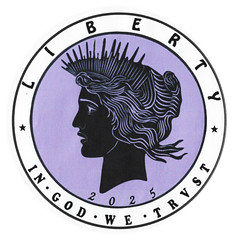 "Regarding the call for niobium coins to reduce the government deficit, I don't know if that was for pure niobium coins or plated.
"Regarding the call for niobium coins to reduce the government deficit, I don't know if that was for pure niobium coins or plated.
"Canada has issued 1 ounce silver coins with some niobium content for years, such as the two illustrated below. The 2016 firefly one sold for US$110.31, while the 2014 flower piece (that's one ugly looking flower!) sold for US$139.95.
"The Royal Canadian Mint usually does not issue just one coin. Niobium adorned coins come in either three or four to a set.
"Mintages run up to 6,000. If you multiply the quantity 10-fold based on population, it wouldn't help the deficit much, but give collectors of gift-ware something else to add to their accumulation of non-coinage coins."
To read the earlier E-Sylum article, see:
NOTES FROM E-SYLUM READERS: MAY 21, 2023 : Bullion Coin Designs
(https://www.coinbooks.org/v26/esylum_v26n21a11.html)
Visiting the Surviving Byron Reed Collection at the Durham Museum
Max Hensley writes:
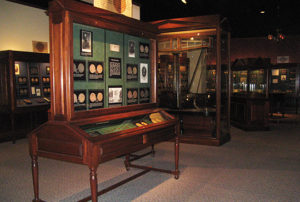 "Many thanks for the piece on Reed/the Durham Museum in Omaha. We have a family farm in NW Missouri we visit twice a year. One time we went up to Omaha to see the UP Museum but didn't know the Durham even existed. Enlightenment comes to Grasshopper. I'll go up there in October."
"Many thanks for the piece on Reed/the Durham Museum in Omaha. We have a family farm in NW Missouri we visit twice a year. One time we went up to Omaha to see the UP Museum but didn't know the Durham even existed. Enlightenment comes to Grasshopper. I'll go up there in October."
Glad to help. I'm adding this to my bucket list, too. -Editor
To read the earlier E-Sylum article, see:
BYRON REED (1829-1891)
(https://www.coinbooks.org/v26/esylum_v26n21a18.html)
Miss Anna W. Williams Illustration
Julia Casey writes:
"A member at the NGC Collectors Society ("coinsbygary") posted an image of the New York Recorder illustration mentioned by Patrick Parkinson."
Thanks. Nicely done. -Editor
To read the earlier E-Sylum article, see:
Inspirational Ladies
Lady Liberty, Miss Anna W. Williams
(https://coins.www.collectors-society.com/wcm/CoinView.aspx?sc=147069)
To read the earlier E-Sylum article, see:
NOTES FROM E-SYLUM READERS: MAY 21, 2023 : Print of Miss Anna W. Williams
(https://www.coinbooks.org/v26/esylum_v26n21a11.html)
Bechtler $5 Wooden Box Owner Sought
Robert Cassling submitted a follow-up and new question about that box accompanying his purchase of a Bechtler $5 coin. -Editor
 Amazingly, the little Newman Bechtler $5 box I inquired about last week arrived with the coin! So that part of the mystery is solved.
Amazingly, the little Newman Bechtler $5 box I inquired about last week arrived with the coin! So that part of the mystery is solved.
I am now looking into the origin of the box and wonder about your thoughts.
It measures 1.25 inches X 1.5 inches.
I contacted Ron Guth (Numismatic Detective Agency) and he sent me this clue:
"Most of Newman's Pioneer gold coins came with a small, protective cardboard box. I don't know of any other Newman coins that were accompanied by these types of boxes; rather, most of his coins were stored in small kraft envelopes on which Newman typed the coin descriptions and cost codes.
Because of this, I suspect that Newman purchased most of his Territorials en masse, which means they probably came from Colonel Green via Newman's partnership with B.G. Johnson, which means they probably came from Waldo Newcomer."
If Ron is correct, this box likely belonged to either Green or Newcomer. If true, this would solidify the coin's provenance.
Is there an Eric Newman expert out there who might have information?
Do you know anyone familiar with these boxes in reference to Newcomer or Green?
Do you know anyone familiar with the handwriting of Newman, Green or Newcomer?
Can anyone help? -Editor
To read the earlier E-Sylum article, see:
NOTES FROM E-SYLUM READERS: MAY 21, 2023 : Newman Bechtler $5 Wooden Box Sought
(https://www.coinbooks.org/v26/esylum_v26n21a11.html)
VOCABULARY TERMS: MONOGRAM FILLER, MORTUARY MEDAL, MOUNTING
Here are a few short entries from Dick Johnson's Encyclopedia of Coin and Medal Terminology. -Editor
Monogram Filler A crayon-like wax material which when rubbed over sunken relief – monograms, letters, figures particularly – fills the incise relief with its contrasting composition to aid legibility. It is available in a variety of colors and lusters, is especially useful for edge lettering appearing on medallic items, and tenaciously holds within the sunken relief. The application is made at room temperature (in contrast to lacquer stick fill-in where the metal must be heated). See fill-in.
To read the complete entry on the Newman Numismatic Portal, see:
Monogram Filler
(https://nnp.wustl.edu/library/dictionarydetail/516355)
Mortuary Medal. A medallic item issued on the occasion of the death of the person portrayed or indicated on the item. Also called Death Medal or Funeral Medal. Albert Frey states that the term mortuary was also applied to coins issued by one monarch shortly after the death and in honor of his predecessor. The larger class of these items are medals, however, and could be applied to any medallic item mentioning the death or funeral of a person.
Reference:
NE12 {1917} Frey, p 155.
To read the complete entry on the Newman Numismatic Portal, see:
Mortuary Medal
(https://www.coinbooks.org/v26/esylum_v26n21a17.html)
Mounting. A collective term for any form containing one or more numismatic items for display, wearing, hanging, protection, storage or housing. Includes: albums, plastic holders, envelopes of all kinds, frames, hangers, stands, supports, wall plaques and such. It also includes ribbons and all forms of suspension.
Individual medallic items have also been applied with various forms of mounting: hangers and such. Jewelry-like items – as bezels – have been applied to medals and coins. Sometimes these are removed, the German language even has a word, henkelspur, meaning traces of the mounting is still visible. Both French and German have terms for has been mounted
: French, traces de monture; German, fassungsspuren.
To read the complete entry on the Newman Numismatic Portal, see:
Mounting
(https://nnp.wustl.edu/library/dictionarydetail/516364)
LEONARD S. FORRER (1869-1953)
E-Sylum Feature Writer and American Numismatic Biographies author Pete Smith submitted this article on author Leonard Forrer. Thank you. -Editor
This week I looked at my bookshelf to see if there was an author worthy of some promotion. I strayed from my normal course and went outside American numismatics.
Forrer produced a great reference on numismatic artists. It was an expensive reference when I acquired it. The current value is a fraction of that original cost.
He was born at Winterthur, Switzerland, on November 7, 1869. He was the son of Abraham Leonard Forrer (1840-1920) and Gabrielle Tapernoux (1846-1877). He was described as an extremely delicate child with a short expectation of life. He went to study in England in 1887, and two years later in 1889 he began work for London art dealer Spink and Son and continued until retirement in 1952. With his contributions, the firm grew into a major European dealership. He catalogued his first collection in 1889 in French as he was still learning English. He was co- founder and editor of Numismatic Circular which began publication in December 1892. The Numismatic Circular carried articles that included biographies of medalists. These were later included in his Dictionary of Medalists. On March 24, 1894, he married Alice Hermenence Rohler (1870-1919) in Cernier, Switzerland. They had two sons and a daughter. Both sons continued in the coin business. After the death of his first wife, he married Edith Frieda Woodman (1892-1975) in 1921.
In the 1901 Census, he was living in Chislehurst, Kent, England and working as a numismatist. In 1911, he was in Bromley, Kent.
Leonard Forrer of Bromley, Kent, England, joined the American Numismatic Association on April 1, 1922, as member 2354. He did not attend the 1927 convention but submitted a paper read by S. H. Chapman.
He was a Fellow of the Royal Numismatic Society in 1898 and elected an Honorary Fellow in 1939. He was a founding member of the British Numismatic Society and given honorary membership in 1950.
He was a founding member and first president of the International Association of Professional Numismatists, (IAPN) founded in 1951.
His major publication was Biographical Dictionary of Medalists, Coin, Gem, and Seal Engravers. Mint-Masters, &c. Ancient and Modern With References to their Works. B. C. 500 – A. D. 1900. This included biographies but also listings of the medals produced by each artist.
This was initially six volumes with the first covering A-D published in 1904. This was followed by E-H in 1904, I-MAX in 1907, M-Q in 1909, and R-S in 1912. The series was completed with T-Z published in 1916. These were published by Spink & Son Ltd, in London.
Once something is published, omissions are noted. Supplemental Volume VII covering A-L was published in 1923 and Vol VIII covering M-Z was published in 1930 to complete the supplements.
One criticism of the series was the lack of a subject index. The Royal Numismatic Society produced an index, compiled by Joan S. Martin and published in 1987 after her death. She worked for the British Museum Department of Coins and Medals.
The eight-volume series was reprinted by Spink in 1960, followed by a 1970 reprint by Bert Franklin. It was later reprinted by Baldwin & Sons Ltd. Of London and A. G. van der Dussen b.v. of the Netherlands. These reprints are not dated but attributed to 1980.
In 1987 The Numismatist carried an ad from A. G. van der Dussen b.v. offering the Baldwin reprint and 1987 Index at $70 per volume or $485 for the set off eight volumes.
Forrer died at home in Bromley, England, on November 17, 1953. He is buried at Plaistow Cemetery. Bromley, with his second wife, Frieda. His obituary in The London Daily Telegraph of November 18. 1953, was brief.
His obituary in the British Numismatic Journal was more extensive. C. H. V. Sutherland wrote:
He was the tranquil possessor of qualities of gentleness, kindness, courtesy, and personal
modesty to an extent which could never fail to effect and mould all those who were in contact
with him. His character was fine and rare: he was a man who could as little reproach others as he
himself reproached.
His library was sold at auction by Spink & Son in 1954.
The Art of Collecting Coins: A Practical Guide to Numismatics by Leonard Steyning Forrer was published by Arco in 1955. That was the son (1895-1968) of the subject of this article.
A pioneering work still of great use today. -Editor
JULIAN LEIDMAN INTERVIEW, PART FOUR
Greg Bennick's latest interview for the Newman Numismatic Portal is with dealer Julian Leidman. Here's the fourth part, where Julian talks about coin dealing and grading. -Editor
Greg Bennick: So, let's shift gears a little bit and talk about Bonanza, and what it's been like owning a coin store over the years. I know you mentioned that the auctions themselves have changed quite a bit over the years, from the dynamic of having people in the room screaming and yelling. What's owning a coin store been like over the years, with the rise of the internet and - I don't want to lead the question too much, but tell me what owning Bonanza has been like over the last half-century or so.
 Julian Leidman: Well, I started dealing coins full-time in 1965. And at the time, Al and his father
had started Bonanza, and they moved Bonanza to downtown Silver Springs. And then Al graduated
Maryland, and I flunked out at the same time. And so, I would hang around his coin store all the
time. Eventually, he let me put a desk in the back room, and telephone and stuff like that. But he
didn't retire until 1991, and I then said, well, I can't retire, so I said, let me take over Bonanza.
And we made an agreement, and I moved it around the corner to where it was. It was on a main
street in Silver Springs, Georgia Avenue, and I moved it around the corner on Wayne Avenue.
Right now, it's half a block away from where it was. But Bonanza started back in the 60s, and it's
still going into the 20s. So, it's been very enjoyable.
Julian Leidman: Well, I started dealing coins full-time in 1965. And at the time, Al and his father
had started Bonanza, and they moved Bonanza to downtown Silver Springs. And then Al graduated
Maryland, and I flunked out at the same time. And so, I would hang around his coin store all the
time. Eventually, he let me put a desk in the back room, and telephone and stuff like that. But he
didn't retire until 1991, and I then said, well, I can't retire, so I said, let me take over Bonanza.
And we made an agreement, and I moved it around the corner to where it was. It was on a main
street in Silver Springs, Georgia Avenue, and I moved it around the corner on Wayne Avenue.
Right now, it's half a block away from where it was. But Bonanza started back in the 60s, and it's
still going into the 20s. So, it's been very enjoyable.
You know, I was not an early proponent of standardized encapsulated grading, because I thought there was more to a coin than just a number. And so, I didn't have very much of that. People would come in the store, they would buy coins. Al was really involved with coins his whole professional life. He's incidentally living in Delaware now, and we're very, very close friends. He would do a lot. At the time, back in the 60s, there were vest pocket dealers coming in, there was a lot of wheeling and dealing all over the place. There were bid boards in places. Bonanza never had a bid board, but he would do a lot of wholesale business and stuff like that. And I tried, but as the standardized grading came more into effect, there were less and less dealers, because there wasn't as much opinion involved anymore in the rarity and the condition.
Of course, I would disagree with grades I saw, and I never really got involved with it until Miles Standish visited me once from PCGS. And he said, ‘Listen, you gotta start doing this.' And this is in the late 90s. So, we took a bunch of coins and got them encapsulated. That's where I started with it. And right now, all of my listings on the internet are all either encapsulated or inexpensive, and don't need to be encapsulated. Things have definitely changed. Bonanza today, I mean, I have the store, and people come in and they occasionally buy coins. I used to have many more showcases than I have now. And as people were bringing stuff in, and I was buying it, I was never selling as much. And so, I had to rearrange things, and put new racks up there so I can store coins. And of course, encapsulated coins take even more room than a coin in a tube.
So, now I have just a few showcases, where I used to have eight or 10. And people come in, and they ask, and I say I don't have a lot on display, but let me find you what you need. And I do that sometimes, but less and less people are coming into the store to buy coins, and more and more people are coming into the store to sell coins. And normally, I would work every day, Monday through Friday like everybody else, and I'd come in Saturday afternoons, and I'd come in Sunday afternoons. Now, I was supposed to talk to you today from my store, but I was at a show last weekend, I just slept late this morning, so I didn't go into the store today. But it's the first in a long time where if I'm healthy, I go into the store.
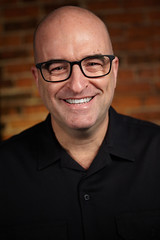 About the Interviewer
About the Interviewer
Greg Bennick (www.gregbennick.com) is a keynote speaker and long time coin collector with a focus on major mint error coins. Have ideas for other interviewees? Contact him anytime on the web or via instagram @minterrors.
To watch the complete video, see:
Julian Leidman Interview
(https://nnp.wustl.edu/library/book/626691)
To read the complete transcript, see:
Julian Leidman Interview (Transcript)
(https://nnp.wustl.edu/library/book/626692)
To read the earlier E-Sylum articles, see:
JULIAN LEIDMAN INTERVIEW, PART ONE
(https://www.coinbooks.org/v26/esylum_v26n20a07.html)
JULIAN LEIDMAN INTERVIEW, PART TWO
(https://www.coinbooks.org/v26/esylum_v26n21a19.html)
JULIAN LEIDMAN INTERVIEW, PART THREE
(https://www.coinbooks.org/v26/esylum_v26n21a20.html)
JULIAN LEIDMAN INTERVIEW, PART FIVE
Greg Bennick's latest interview for the Newman Numismatic Portal is with dealer Julian Leidman. Here's the fifth and final part, where Julian talks about robberies and security. -Editor
Greg Bennick: Well, if it's any consolation, I expected to interview you from Seattle, where I've got professional microphones, and I've got a whole setup going on, but I was at the same coin show that you were, and I'm actually at my parents' place on the east coast. So, instead of my background being all professional, I've got a background with a photo of my great-grandmother on the shelf over there, sitting here on my laptop in the basement. And that works for me. I'm happy to talk to you anywhere, anytime. This is fantastic. Originally, I was going to ask you about the theft and partial recovery of your coins, but I've enjoyed all the things that we've talked about so much that I might want to shift that question a bit in case there's something you want to tell about, because the story is well-known.
I was just maybe going to ask, what advice do you have on security for coin collectors and coin dealers, just to keep people safe? And if people don't know the background, Julian went through a theft and partial recovery of some coins. Again, the story is out there if you'd like to find it, and Julian, you're more than welcome to tell us the story if you like. But really, ultimately, at the end of the day, learning how we can keep ourselves safe, or some ideas and thoughts to keep in mind about safety and security would probably be really helpful for people.
 Julian Leidman: One thing I learned over the years was, you don't leave your coins in your car
unattended. And we followed that religiously when we went to coin shows. I often traveled with
colleagues. I remember traveling all over with my colleagues at Golden Eagle, who's still in
business in Laurel. And we would go, and there would be three or four of us in the van, and the
van would be loaded. And so, if we stopped someplace, two people would go in and eat, and one
person would stay in the car. Well, I made a mistake. In 2009, I was returning home from
Connecticut, a coin show there. I had been there two or three times, I guess. My in-laws lived in
New Jersey, which is between Connecticut and Maryland. So, they said, ‘Why don't you stop here
for dinner?' I was a little hesitant, but...
Julian Leidman: One thing I learned over the years was, you don't leave your coins in your car
unattended. And we followed that religiously when we went to coin shows. I often traveled with
colleagues. I remember traveling all over with my colleagues at Golden Eagle, who's still in
business in Laurel. And we would go, and there would be three or four of us in the van, and the
van would be loaded. And so, if we stopped someplace, two people would go in and eat, and one
person would stay in the car. Well, I made a mistake. In 2009, I was returning home from
Connecticut, a coin show there. I had been there two or three times, I guess. My in-laws lived in
New Jersey, which is between Connecticut and Maryland. So, they said, ‘Why don't you stop here
for dinner?' I was a little hesitant, but...
Now, going back over things, I really think I was followed from there. I don't know for a fact. And when I got to New Jersey, I pulled into their home, and I stayed outside on the porch, with the car. Somebody may have driven by to his house or something like that, and I didn't really pay much attention to it. And then they said, ‘Well, let's go out to dinner.' And that's- I really should have said no. And so, we went to this restaurant on a busy route. I went into the restaurant, I backed into the place where I could see the car right there, and as I was sitting down, the lights are blinking on the car, and I said, well, I must have hit my keys in my pocket. You know, I must have hit the fob or something and it set off the alarm. So, I just clicked it and it went off. I had my dinner, and went outside, and the car had been broken into.
And if I had gone outside at that time, I might have stopped it, I might have gotten shot, I don't know what would have happened. But, in any event, I was horrified. Here's everything I worked my whole life for, and... They got two or three cases, including a suitcase full of clothes. So, we called the local police. I had a friend who's son was with the FBI, I called him, and I never really realized, but the FBI really has to be invited into a case by a local police agency. So, I ended up telling the local policeman what was what. I called some of my friends, I put it out on various numismatic networks that this had happened. The next morning, because I couldn't really drive home that night, I'm driving home with a broken side window in the van. I drove home, and I put out more and more publicity.
And eventually, I got a lead from somebody, and he told me that he's being offered some of these coins, and he mentioned a couple of coins. Very silly coins, but one of which was a valuable, a 1921 Double Eagle that was encapsulated. And also, he mentioned a 1954 S Penny encapsulated in, I don't know, MS65 or 67. Now, this isn't something that somebody would mention to you, but that's what they had told this guy. And so, I called the FBI, who had been involved with it, I told them about this, and they went and talked to the guy, and realized that it probably was the same coins. And they made arrangements to go find out where the coins were, and they were able to go and raid the place where the coins were. And it was on West 47th Street in New York City, the diamond district, where all these guys were buying and selling diamonds, and gold, and coins, and whatever.
And this one guy, who was one that bought, evidently, all these coins, and he had to meet these people in an odd place, and pay them cash or whatever. He made a good buy, but he ended up going to jail because he never would give up who the coins came from. And the FBI, incredibly, recovered a huge amount of the coins, in dollar value too. It could have been 80% or 90% of the value, which was in the millions of dollars. And so, I wasn't dead, although it did take me a long time to get the coins back from the FBI. but they eventually, through the intervention of some of my friends and colleagues- Jimmy Hayes was a former congressman from Louisiana, and Jimmy had obviously befriended other members of Congress, and so he introduced me to Louise Holtzman from New York City, and she was able to write a letter and contact the FBI on my behalf, and I was able to eventually get physical possession.
Even though I had gone and looked at them, and ascertained that these were absolutely the same coins, zero question about it, they were thinking they were going to have to have a trial, and they're going to need to have these coins as evidence, and it didn't really ever happen that way, because they never did find the actual thieves. Because the FBI never- they told me at the time that they never recover more than 5% of what's stolen, and here I had something where they recovered 80+% of the coins. It's absolutely incredible. And so, I was kind of back in business.
Greg Bennick: I'm just glad that you were safe during the robbery, first and foremost, and of course, like you said, that you got such a big percentage back. Are there any tips or ideas you might give to folks just to keep in mind as they're going to coin shows, or as they become a dealer, or as they are dealers, based on your experience, and what you've thought about since then?
Julian Leidman: Well, going to coin shows is less of a problem because nobody knows when you're going, or where you're going to, or anything like that. But, coming home from a coin show is a real problem. I mean, this went back to... for as long as I was in business. Before me, people would leave a coin show, and they'd be followed, and they'd stop, go in to eat, and they come out and their coins are gone, or their car is gone, whatever. So, that's the main thing. If you're going stop to eat, there's got to be more than one of you, and you have got to be in the car. There's just no question about that. So, that's my number one thing. And just watch your surroundings. I remember coming home from coin shows in Florida, I used to go down to Florida for the month of January and do four coin shows in Florida, the FUN show and three other little shows around the state.
And so, we were returning home from one of those trips, and my friend and colleague Don Aft, who I would travel with, he's looking in the back mirror, and he sees somebody following us. So, he pulls into a gas station, and the other car pulled into the gas station. I get out of the car and start walking toward the other car, and the other car backs up down a side road for half a mile, just totally backs up. And we were being followed. So, you have to watch everything. I've been the victim of sneak thieves at coin shows, where people have stolen something out of a showcase or something like that. So, the key is eyes and physical presence. Those are the two main things. And watching who you're talking to. And there's still thieves at coin shows. Just this last weekend in Baltimore, they caught a thief at the coin show.
And I had seen this guy at the Baltimore show for 10 or 15 years, and I never was in a position to lose something to him, but I've lost things to other people because I wasn't really the same eyes and ears, and physical presence that I needed to be. So, those are all very important things. Steve Ellsworth, a retired army colonel, has done a lot with security, and made many presentations to numismatic groups about security. Of course, I understood everything he said, and I made that one mistake. And I made other mistakes too. Mistakes are what cost you, really.
Greg Bennick: I appreciate the story and the insights. It's so important for people. And overall, I appreciate your stories. You've been so generous with your time. We've been speaking close to an hour at this point, and the history and all of it has been just so incredible. I'm just so thankful that you were able to take some time today and speak with me, and share some of your experiences over the course of your career. It's just been wonderful.
Julian Leidman: Well, that's very nice. I'm happy to talk to you. And I can ramble on for- You know, we could do this for another couple of hours too, but I don't think there's anybody that really needs to watch an interview that long. You know more about that than I do. So, I'm appreciative to be able to share the time with you.
Greg Bennick: That's fantastic. Well, if folks are interested in hearing more, you can drop a line to the Newman Numismatic Portal and get in touch with me. My contact information is on the page where you found this interview, and if people are interested in hearing more, we'll do Julian Leidman part 2. But for today, Julian, thank you so much on behalf of myself, and also on behalf of the NNP for taking the time. This has been really fantastic, I really appreciate it.
 About the Interviewer
About the Interviewer
Greg Bennick (www.gregbennick.com) is a keynote speaker and long time coin collector with a focus on major mint error coins. Have ideas for other interviewees? Contact him anytime on the web or via instagram @minterrors.
To watch the complete video, see:
Julian Leidman Interview
(https://nnp.wustl.edu/library/book/626691)
To read the complete transcript, see:
Julian Leidman Interview (Transcript)
(https://nnp.wustl.edu/library/book/626692)
To read the earlier E-Sylum articles, see:
JULIAN LEIDMAN INTERVIEW, PART ONE
(https://www.coinbooks.org/v26/esylum_v26n20a07.html)
JULIAN LEIDMAN INTERVIEW, PART TWO
(https://www.coinbooks.org/v26/esylum_v26n21a19.html)
JULIAN LEIDMAN INTERVIEW, PART THREE
(https://www.coinbooks.org/v26/esylum_v26n21a20.html)
RICHARD LOBEL INTERVIEW PART THREE
Greg Bennick's latest interview for the Newman Numismatic Portal is with London dealer Richard Lobel. Here's the third part, where Richard talks about starting Coincraft. -Editor
Greg Bennick: Yep. Exactly. And move to London as this free spirited wild soul. And then how did Coincraft come about once you were in London?
 Richard Lobel: Right. I started my own company, Richard Lobel and Company Limited. And a
guy who used to work for me owned the name Coincraft, and he had an account, a bank account
in Switzerland, and I think I paid him £500 pounds for the name and the account. And that's how
I got the name, Coincraft. I thought it was fine. And so we've used it since then. It's probably -- I
could have thought of a better name, but it's fine. It works.
Richard Lobel: Right. I started my own company, Richard Lobel and Company Limited. And a
guy who used to work for me owned the name Coincraft, and he had an account, a bank account
in Switzerland, and I think I paid him £500 pounds for the name and the account. And that's how
I got the name, Coincraft. I thought it was fine. And so we've used it since then. It's probably -- I
could have thought of a better name, but it's fine. It works.
Greg Bennick: It's great. It absolutely works. Now, you're a free spirited youth, you're running around London, you're sleeping past breakfast because you've been out partying all night.
Richard Lobel: Right.
Greg Bennick: Where did the transition point come from between that, and maybe that continued into Coincraft. But where did the transition point come from between staying up all night, that sort of thing, and then paying the £500 pounds for the Coincraft name at which point you're underway and in business?
Richard Lobel: Well, I was -- In those days, you had three big dealers. You had Seaby, Spink,
and Baldwins. And then you had the joker in the pack, you had a man called Geoffrey Hearn,
who is unbelievable. And the first -- I moved here October, and the first Christmas I spent
actually in Ireland with Geoffrey Hearne, his brother, Bernard Hearn, who was also a coin
dealer, and my mentor, Peter Gerald Maundy Allen. And these were a hard drinking, hard
playing group of people. Geoffrey had been invited to a coin dealer's home for the weekend, and
the coin dealers' daughter had just come out of a convent. And when he left, he took not only the
daughter, but the coins.
At the time, Geoffrey was the most important individual dealer around. At auction if you wanted
a lot, you would be better to pay him 5% commission. Otherwise, he'd buy the lot just to spite
you. He had the most incredible -- he had, in 1954, he put out catalogs, Edward VI crowns, 1551
UNC, 1551….I mean, he had incredible material. He also had a very checkered background,
shall we say? A friend of mine once went to his office And I don't know if you've heard of the
Kray Brothers, the most notorious gangsters in England. And he walked into Geoffrey Hearn's
office and the Kray Brothers was there and Geoffrey just said, go away, go away. But he was an
incredible guy. He was…they talk about the Una and the Lion, the five pound piece that now
sells for a quarter of a million pounds.
I remember Geoffrey actually bringing three Una and the Lions out of his pocket and he wanted
£1,800 pounds, not each, but all three for £1,800 pounds…but who had £1,800 pounds in those
days? It was wonderful thing. When I moved to England on Great Portland Street, there were
seven coin shops on this one street. And there were others scattered around. Now I'm not sure
there are seven coin shops in London…in all of London. But it was great. And you went to the auctions. I mean, Mr. French at Glendining, the best auctioneer ever, very austere, I must admit.
After -- in a year and a half or two years, I decided I wanted to try and get credit there, and I had
all my reports and all this. And I went in and I you know, he was very…never Bill
. It was
always Mr. French. And I said to him and he said, You know, I've been buying from some time
Mr. French. I'd like to try and get credit. He said,
That's all right. Fine. Okay.
And I said,
Well…but you haven't told me how much?
He said, Mr Lobel, I don't expect you to spend
more than you can afford to pay for.
And that was the way it was. And it was fantastic. In those
days, you could make a fantastic living. I remember before I got credit, there was one mixed lot
of 700 coins at Glendening's. And I found a rare US five cent piece, half dime, in it, 1800
something.
And I figured, oh, the lot's worth more, but I can bid up to £115 pounds and the check will clear.
At £125 pounds maybe not. And I bought the lot for £44 pounds. And I dumped it out and I
found not one but three rare US half dimes in it. And the dealer paid me £300 pounds. I mean,
you're talking about where I was paying £15 pounds a week for a flat at that point. And it was all
cash money. There were no taxes, there were no VAT. For a youngster, it was….
And the coin dealers I grew up with, many of them are still around, some are not, some are dead,
whatever. We had a ball. You know, it was a fantastic time. It was so exciting. Everything was
new, it was exciting. There were auctions. There were coin dealers to go to. They had junk lots. I
mean, that to me is the one thing in the coin business that is missing today: junk lots. I used to
love, in Boston, going through junk lots. You know, you'd find incredible things in them. It's
changed. You know. You're making more money, but it's not as much fun.
Greg Bennick: It sounds like a grand adventure back in the day from what you're describing. I mean, you've got the wild Richard and this untamed frontier of a hobby with people diving in. It just sounds quite remarkable.
Richard Lobel: It was incredible. I mean, and I grew up with a group of people, a number of them are still around. You know, and after 50 odd years, you don't have to say much to them. You know whether it's good or bad or whatever. I had one in today who I've known for 54 years. And he bought, sold me some stuff. I know he's got too much merchandise, he could use some cash. That's fine. So, I bought it. Although when I say cash, because of the problem with the money laundering, we no longer deal in cash. Up to £100 pounds, we will pay you cash. Otherwise, we wire the money to your account. Because in this country, if I wire the money to your account, not for today, but for tomorrow, it costs me 35 pence. If I write a check, it costs me 70 pence.. So, it saves a lot of problems.
Greg Bennick: It sounds like it. It sounds like it. Okay. So, you're going to auctions. You are deeply involved in the coin industry. It is the high time of collecting and dealing in London.
Richard Lobel: Yeah. Absolutely.
Greg Bennick: Coincraft starts. You pay £500 pounds for the name. Where do you set up shop at this point?
Richard Lobel: Ah. I had two rooms on Morley House at Upper Regent Street, there were two 8
foot by 10 foot rooms. I didn't have much space, and I hired a friend of mine, John Casey's
girlfriend as a secretary, and I paid her £15 pounds a week. But her spelling was even worse than
mine. My spelling has never been good, and hers was…
But it was fine. We had an office, and we're on a third floor, or fourth floor. And even when
there was no electricity, there was no lift, people would still walk up. Collectors, as a collector
myself, collectors are crazy. They must own, they must have, they must -- and I enjoy that.
I had a collector in today who's been with me 30 years. He's an MBE, which is a Member of
British Empire. And he's 93 years old. He looks healthier and stronger than I do and we had a
great chat. First time I had met him, we've dealt through the post and we've written a few times.
But he was so delighted with the way we do business, because one of the things when you said,
asked about investments. And for my sins, and I say that honestly, in the early 70's for a year and
a half, two years, I sold coins as investment. I have never sold them since. We sell – and I want
this to be in big bold letters. We do not sell anything for investment. We sell to collectors. We
want people to enjoy themselves. And when someone comes in and they've been looking for a
coin for 20 years and I can say, Yes, I have it
and it doesn't have to be expensive. It'll be £20
pounds or 30…. It gives me great joy in supplying them with what they're looking for. Does that
make sense?
Greg Bennick: Absolutely. It's fantastic. I love hearing this.
Richard Lobel: And this guy today, thanked me for -- because we run the business the way he wanted it. He's old fashioned, which is fine. It's a family owned and family run business. My wife Claire is in charge of the banknotes, and she's one of the world experts on banknotes. We have another couple couples working for us. I think we have, and I'm bragging, but I think we have the best staff of anyone in the coin business in the UK. And they enjoy doing it. We do things that…when it's your birthday, you get a card that's literally signed by everyone in the office, and we give you £20 pounds, so you can go buy a little something. You know, it's just that we want to remember your birthday, we want to enjoy it. I think that the staff really enjoy working there. If it's been a good year and most years have, at the end of April, you get a 13th month salary as a bonus. And that's everyone from the cleaner to the directors. Well, you know, that's just the way we do it.
Greg Bennick: That's amazing.
Richard Lobel: Luckily, I'm not doing it for the -- I mean, I still want to make money, don't get me wrong. But I'm not doing it for the money. I've done well enough. But I'm doing it because I enjoy it and I really love it.
Greg Bennick: I can tell. It's quite obvious and it's infectious in a way. I'm just so excited to be able to talk to you today about all this because at the end of the day, I'm really a collector. Sure, I sell things from time to time and buy things from time to time.
Richard Lobel: Everyone does. Everyone does.
Greg Bennick: I'm a collector at heart and always have been, so I really appreciate hearing your perspectives. Now, you go from two 8 by 10, I think you said, rooms.
Richard Lobel: Right.
About the InterviewerGreg Bennick (www.gregbennick.com) is a keynote speaker and long time coin collector with a focus on major mint error coins. Have ideas for other interviewees? Contact him anytime on the web or via instagram @minterrors.
To watch the complete video, see:
Richard Lobel of Coincraft Interviewed for the NNP by Greg Bennick
(https://nnp.wustl.edu/library/book/626832)
To read the complete transcript, see:
Richard Lobel of Coincraft Interviewed for the NNP by Greg Bennick (Transcript)
(https://nnp.wustl.edu/library/book/626831)
To read the earlier E-Sylum articles, see:
RICHARD LOBEL INTERVIEW, PART ONE
(https://www.coinbooks.org/v26/esylum_v26n21a08.html)
RICHARD LOBEL INTERVIEW PART TWO
(https://www.coinbooks.org/v26/esylum_v26n21a09.html)
RICHARD LOBEL INTERVIEW PART FOUR
Greg Bennick's latest interview for the Newman Numismatic Portal is with London dealer Richard Lobel. Here's the fourth part, where Richard talks about the business Coincraft has become today. -Editor
Greg Bennick: What is the scope of Coincraft today? I'm assuming that was sometime around, let's say that, or like you said, the early 70s or so. How did it grow? What did it become?
 Richard Lobel: In 1976, we rented a shop across from the British Museum, and we slowly
kicked everyone out, and we -- about 20 odd years ago, we had the chance to buy the building. It
was financially a big crush. It was tough. But we bought it. So, we own the building. We're a
strange firm -- we don't borrow any money from the bank, which most American coin dealers
cannot believe. We're totally self-financing. We own the building outright. We've paid it off and
we have two other locations, let's say, 7,000 square feet of space, which they're complaining that
I keep buying too much and we might run out of space again. I love buying. I absolutely -- I just
don't like selling.
Richard Lobel: In 1976, we rented a shop across from the British Museum, and we slowly
kicked everyone out, and we -- about 20 odd years ago, we had the chance to buy the building. It
was financially a big crush. It was tough. But we bought it. So, we own the building. We're a
strange firm -- we don't borrow any money from the bank, which most American coin dealers
cannot believe. We're totally self-financing. We own the building outright. We've paid it off and
we have two other locations, let's say, 7,000 square feet of space, which they're complaining that
I keep buying too much and we might run out of space again. I love buying. I absolutely -- I just
don't like selling.
Greg Bennick: Incredible. So, you've got all the space and you've got an entire building across from the British Museum at this point.
Richard Lobel: Yes. We have a -- well, there's a flat above. But, yes, we have the entire building, we own the building. And we're literally, we've got a giant Victorian penny that must be, I don't know, 5 foot across as a sign outside. You know, it's one of the few places in London where you come in and look and these things on display and everything's priced. Because I think there's nothing worse than going into a place and not seeing something priced. You know, if you don't price it, you're ashamed of it. This is the price we want. And as for discounts, we very rarely give discounts unless you're a good customer and you're spending some, you know. We basically tell people we're a fixed price shop. And that's what it is. And we've got all new -- well, not all new staff, but new people and they enjoy being there and they enjoy talking to the people and helping the people. And it's great. You know? I love it.
Greg Bennick: This is wonderful. Now, given the scope of Coincraft, yet the personal nature of it, meaning it's obviously become immense and you're processing tons of orders, yet you're still personal in terms of your approach to your customers. You probably have a good sense of what people are collecting more or less. And my question is, what are people collecting in London? Because in the States, I can -- I've got a pretty good handle on what people are looking for at the major coin shows and that sort of thing. But in London, what are people collecting?
Richard Lobel: Well, let's start off with the modern things from the Royal Mint. And the Royal Mint and I have a love-hate relationship. We both love to hate each other. Except that when the Queen died, they ran out of coins, and they had to buy them from me. I sold them 24,000 1953 Coronation Crowns because I thought over the years it was cheap, but I kept buying them. You have to understand when I say a large inventory, if you want 20,000 1977 crowns. That's no problem. If you want 10,000 Churchill crowns, if you want 1,440 Charles and Diana Crowns in Silver Proof, that's no problem. We have them. It's all paid for. I don't owe anybody any money, so I can do what I want.
Greg Bennick: So, the inventory is massive. It's what you're saying basically.
Richard Lobel: I would say yes. Yes. I would say it's -- I mean, with my wife's thing and the banknotes, we've handled a lot of hoards of banknotes. We owned and have been disbursing the hoard of Italy's first banknotes from 1746 to 1798. We bought them originally from Guido Crapanzano in Italy. I bought them actually in partnership with David Laties from Educational Coin Company. And six months later, he sold me his half. So, we're down to about a million dollars catalog left of them. As I say, I love buying. I don't mind quantity. When the £5 pound note changed from paper to polymer, I went and bought 5,000 pieces of the £5 pound note in paper and just put them aside. Because I think they're great. Nobody else has them.
Greg Bennick: Well, I know who to go to if I ever need 5 or 10 or 20,000 of anything, in the future.
Richard Lobel: Don't forget, I bought that hoard of British military notes - it was 17 million banknotes and it weighed 15,000 kilos. Did you ever see what -- that Harrison Ford film where he he's chasing the, I don't know, one of the things. And at the end, they throw it in the back of this huge warehouse.
Greg Bennick: Raiders of the Lost Ark. Yes.
Richard Lobel: Right. Okay. That's it. Sorry. They found 17 million banknotes in Berlin that were made for the British military, and I was head of the consortium that bought them at the time. That was one of the times we had the Guinness Book of World Records…it was the largest and heaviest and most expensive lot of banknotes ever sold at the time.
Greg Bennick: Unbelievable. Unbelievable. Okay. So, a question for you. Going back a few minutes, to something you mentioned. Tell me about the difference as you see it between coin collecting as a hobby and coin buying as an investment. You said you don't sell coins for investment….
Richard Lobel: Not at all. If you came in with £50,000 pounds in cash and wanted to invest in coins, we'd say no. We would try and convert you to become a collector and how much more fun it can be. But, no, we don't sell anything of investment. We just don't do it.
Greg Bennick: Now, and my question then is and I'm just curious. It makes perfect sense why you would want to take the approach that you do, and I appreciate it so much. But a business mind would say, well, you could make a profit on that person's £50,000 pounds and sell them an investment. Yet, why do you then choose from a business perspective not to do it? I mean, is it just out of love for the hobby?
Richard Lobel: Because in the early 1970s I sold coins as investment. And everything went fine until the coin market went down and people wanted to sell, and I felt sorry for them. You know? I decided at that point, no, I wasn't going to do it.
Greg Bennick: That makes perfect sense. That's really honorable. And also, it increases your fun. When you focus on the fun and the collector, the collector who comes in, rather than the investor. It just -- it means that you're in touch with more kindred spirits like yourself.
Richard Lobel: I look at the American coins and I see the rare coins, and I see that 18 different people have owned it in the last 10 years. They're not collectors. They're bloody investors. I don't need the money. You know, I'm happy enough with the business we run. I know we could make a lot more money. But I'm happy enough doing what we're doing. That's -- I live very comfortably. I live in a mews house. You know what a mews house is?
Greg Bennick: I don't actually. Tell me.
Richard Lobel: Okay. In the old days, you had the big houses. And in the back, you had a stable. Where the horses stayed and the grooms lived on top, on the first floor. That's called a mews, M-E-W-S. And I live in a mews which is actually great because it's a cul de sac. And my next door neighbor is the Swiss embassy. Literally, I have a wall with the Swiss embassy. And, of course, they've carted them up tremendously, and it looks really much better, and they're very expensive now because everything in London is bloody expensive. But yeah. You know, I'm happy doing that. I live comfortably. I have a nice house, got 3 bedrooms, 3 bathrooms, got a garage. I don't have a car but I've a garage. I've got everything I want.
 About the Interviewer
About the Interviewer
Greg Bennick (www.gregbennick.com) is a keynote speaker and long time coin collector with a focus on major mint error coins. Have ideas for other interviewees? Contact him anytime on the web or via instagram @minterrors.
To watch the complete video, see:
Richard Lobel of Coincraft Interviewed for the NNP by Greg Bennick
(https://nnp.wustl.edu/library/book/626832)
To read the complete transcript, see:
Richard Lobel of Coincraft Interviewed for the NNP by Greg Bennick (Transcript)
(https://nnp.wustl.edu/library/book/626831)
To read the earlier E-Sylum articles, see:
RICHARD LOBEL INTERVIEW, PART ONE
(https://www.coinbooks.org/v26/esylum_v26n21a08.html)
RICHARD LOBEL INTERVIEW PART TWO
(https://www.coinbooks.org/v26/esylum_v26n21a09.html)
THE BOOK BAZARRE
BAHRAIN NATIONAL MUSEUM COIN EXHIBIT
A new exhibit at the Bahrain National Museum highlights the history of ancient Arab coins. -Editor
An exceptional exhibition of numismatic collectors entitled Coins Through Culture and History
was unveiled yesterday at the Bahrain National Museum. Present were Minister of Youth and Sports Affairs Eyman bin Tawfeeq Al-Moayed, Bahrain Islamic Bank (BiSB)'s Chief Corporate and Institutional Banking Officer Jawad Humaidan, and numerous other officials.
In collaboration with the Bahrain Antiquities and Cultural Authority (BACA), Arados Auctions founder and numismatic expert Mohamed AlAradi organised this exhibition to highlight the history of ancient Arab coins.
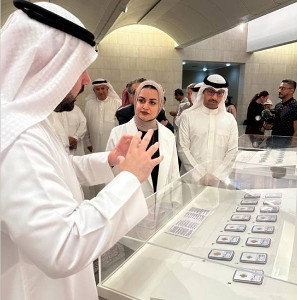 The purpose of this event is to give individual coin collectors a chance to display their coins at the Bahrain National Museum.
The purpose of this event is to give individual coin collectors a chance to display their coins at the Bahrain National Museum. The speciality of this exhibition is to distribute the knowledge of coins to the general public,
said Director of Archaeology and Museums Salman Almahari in an interview with The Daily Tribune. Through the exhibition, several aspects will be explored, including the cultural, economic, and political roles of the Romans and Arabs.
Coin collector Aqeel Almosawi told The Daily Tribune that this was the true evidence of Bahrain's history and its showcasing change of coins throughout the transitional period.
The opening ceremony of the exhibition, which was sponsored by BiSB, will take place from 8 am to 8 pm, except on Tuesdays, until June 22.
To read the complete article, see:
Ancient Arab coins on display at Bahrain National Museum
(https://www.newsofbahrain.com/bahrain/90405.html)
PAYING RENT WITH EELS IN MEDIEVAL ENGLAND
Mike Kodysz passed along this interesting article about how "eels essentially became currency" in medieval England. Thanks! -Editor
 JOHN WYATT GREENLEE, A MEDIEVAL historian focusing on cartography, never intended to become the
JOHN WYATT GREENLEE, A MEDIEVAL historian focusing on cartography, never intended to become the Surprised Eel Historian,
as he dubs himself on Twitter. When he first proposed his Ph.D. project on eels, it was declined. Greenlee went ahead and studied eels anyway, and his passion for these wormlike, elongated fish has now managed to capture the fascination of others. Greenlee specifically looks at the role eels played in medieval English economy and culture—a role far more important than many would think. In medieval England, eels essentially became currency. Medieval peasants would use the fish to pay their rent and make other economic transactions.
We have a really great and complicated history with eels,
says Greenlee. Medieval land users were required to pay rent to the landowner each year, and in many cases, these rents were paid in kind.
This means that they weren't paid in coins, but rather with goods, such as chickens, eggs, and—Greenlee's favorite—eels. The first recorded rent payment made with eels was in 700. By the time of the Domesday Book survey in 1086, a massive land survey conducted in England after William the Conqueror seized the island, we can see evidence for something more than half a million eels being paid in rent in England every year,
says Greenlee.
When it comes to their numbers in comparison to other in kind
rents, Greenlee emphasizes their popularity: There are more rents paid in eels than anything else in the Domesday survey.
The question is: why? Paul Freedman, a medieval historian at Yale University, explains that eels were somewhere in between a delicacy and an everyday item. The fact that people were asked to pay rent in eels shows that their landlords wanted them.
Most of the eel rents were paid in East Anglia, which is really great eel territory,
says Freedman, because of the numerous marshes and low-lying areas with lots of water. Greenlee explains that a lot of mills end up paying rents in eels, probably because they catch a lot of eels near the mill races.
Monasteries and religious institutions also carried out a large number of eel transactions. In the Catholic world before the Reformation, there were lots of days in which you had to abstain from meat, particularly Lent before Easter. Meat markets shut down, and fish was the primary product,
says Freedman. He notes that one reason for their popularity, apart from that they're very plentiful and could be [easily] gathered, was that the demand for fish was much greater than it is now because up to 120 days a year the consumption of meat was prohibited.
Since eels were an appropriate Lent meal, monasteries saw them as a highly sought-after commodity and collected them in droves from their tenants. Some monasteries received tens of thousands of eels in rental transactions, stockpiling the eels to then pay for their needs.
These eel rent transactions are displayed in Greenlee's interactive map, which highlights rental payments made with eels throughout England from the 10th century up until the end of the 17th century. The transactions vary from single digits to the tens of thousands of eels. One enormous transaction shows that Ely Abbey, now known as Ely Cathedral, paid Thorney Abbey 26,275 eels to rent a fen (similar to a wetland), according to rare transaction records on parchment fragments held by the British Library.
Over time, the practice of paying rent with eels slowly declined. The reasons for this are unknown. Greenlee explains that some of it has to do with availability of money, some of it has to do with changes in habitat and ecology.
In addition, the beginning of the Little Ice Age in the 14th century could have caused water bodies to become colder, leading to a reduction in eel populations. Kerr notes that measuring eel populations is incredibly difficult,
and that even today eels are difficult to count, study, and understand: as with everything with eels, it's complicated.
To read the complete article, see:
To Pay Rent in Medieval England, Catch Some Eels
(https://www.atlasobscura.com/articles/medieval-eel-rent-map-england)
THE COINAGE OF CONSTANTINE
An new CoinWeek article by Mike Markowitz looks at the coinage of Byzantine emperor Constantine. Here's an excerpt - see the complete article online. -Editor
THE FOURTH BYZANTINE emperor of the Macedonian dynasty
, Constantine VII is remembered as Porphyrogenitus, meaning Born in the Purple
. The term applied to rulers born while their fathers held the throne. The palace in Constantinople even had a Purple Chamber
where the empress would give birth, its walls lined with slabs of porphyry, a prized reddish purple marble quarried in Egypt.
Constantine's father Leo VI (Leo the Wise
, ruled 886-912), like the future English king Henry VIII, had terrible luck fathering a male heir. Three successive wives died without delivering a son. Leo's mistress, Zoe Karbounopsina (She of the Coal-Black Eyes
) bore Constantine on May 17, 905. The Orthodox Church disapproved of third marriages, and absolutely forbade fourth marriages. Defying the Church, Leo married Zoe on January 9, 906, making her his empress. Young Constantine was formally crowned as co-emperor at the age of two.
Leo and Constantine
Leo VI the Wise, with Constantine VII. 886-912. AV Solidus. Image: CNG. Constantine's first appearance on a coin, alongside his father, dates to that coronation. On the reverse, the infant boy is depicted – rather hopefully – as a beardless adolescent, only slightly smaller than Leo. They stand in imperial garb, holding a double-barred patriarchal cross between them.
The coin's obverse shows Christ enthroned with the Latin inscription Jesus Christ, King of Those Who Reign
(+IHS XPS REX REGNANTIUM*), which had been used on the gold coinage since the reign of Constantine's grandfather, Basil I (ruled 867-886). When Leo died, his dissolute brother Alexander took the throne, pushing Constantine aside and exiling Zoe to a convent. Alexander died after a year, from excessive eating and drinking. Coins of his brief reign are very rare.
Constantine and Zoe
Constantine VII Porphyrogenitus, with Zoe. 913-959. AV Solidus. Image: CNG.
In 914, Zoe escaped from the convent wherein she had been detained, and with the aid of loyal palace officials, took up the regency for her nine-year-old son. Zoe and Constantine appear side by side on a rare gold solidus. Zoe wears the loros, which is an elaborate jeweled wrap reserved for rulers, and a heavy crown with dangling strings of pearls. Constantine, beardless, wears the chlamys, which is a pleated garment fastened with a round gold brooch. Only about a dozen examples of this coin have appeared on the market in recent years.
Constantine VII and Romanus I, with Zoe, Æ Follis. Image: Roma Numismatics.
Mother and son also appear on a quite affordable copper follis, the reverse inscribed Constantine and Zoe, Emperors of the Romans
.
To read the complete article, see:
Born Into the Purple: The Coinage of Constantine VII
(https://coinweek.com/born-into-the-purple-the-coinage-of-constantine-vii/)
FIRST COMMON ERA DATE ON A COIN IS 1234
Here's an interesting numismatic tidbit from a Stack's Bowers blog article by Chris Bulfinch. -Editor
Ancient and earlier medieval coins are often dated by regnal year, not by year-dates of the Julian/Gregorian calendar. The practice of applying Common Era dates to coinage began in the thirteenth century, with the first Common Era date borne by a coin being 1234, applied to a bronze coin struck in Denmark under the reign of Valdemar II. This bronze coin has the date in Roman numerals on the reverse. Seven examples are known, one of which resides in private hands. That the first Common Era date featured on a coin is composed of ascending digits is certainly interesting.
Another coin struck in the early thirteenth century which could plausibly claim the moniker of first Common Era-dated coin,
a silver obol struck in Toledo in 1166. It bears the date 1204 of the Hispanic Era,
a dating system in use on the Iberian Peninsula in the Middle Ages.
Blog readers are encouraged to check out Robert A. Levinson's The Early Dated Coins of Europe, 1234-1500.
A useful CoinsWeekly piece on the issue: https://coinsweekly.com/two-contenders-for-the-first-christian-era-dated-coin/
To read the complete article, see:
DID YOU KNOW THAT THE FIRST COMMON ERA DATE ON A COIN IS 1234?
(https://stacksbowers.com/did-you-know-that-the-first-common-era-date-on-a-coin-is-1234/)
COUNTERFEIT KENNEDY HALF DOLLARS
A PCGS blog article by Jay Turner examines counterfeits of common Kennedy halves. -Editor
After working professionally as a coin grader for over 20 years, I am still surprised by what can cross my desk. Recently while grading coins from a PCGS express submission from Hong Kong, two such surprises were in a single submission. Submitted as a crossover from an alternative service based in China were two counterfeit Kennedy Half Dollars.
The Kennedy Half Dollar is not a coin that many would think as a target for counterfeiters. However, whoever produced these counterfeits must have believed that it was profitable to do so. The pieces submitted were dated 1968-D and 1969-S, which, if authentic, would be made from a 40% silver composition and, at today's melt value at around $25 an ounce, would represent an intrinsic value of around $3.75 a coin. However, neither piece was silver. Yet, regardless of the minimal value, the existence of these two counterfeit Kennedy pieces purporting to be common dates is something that should be noted.
The first piece mimicking a 1968-D Half Dollar has countless things wrong with the product that under minimum scrutiny would identify it as counterfeit. The surface and design are completely incorrect for a United States Mint product. For example, magnifying the bust of John F. Kennedy, one can see that the surface is textured, almost pixelated, in how poor the design transfer was done. This incorrect aspect is found across most of the design of the coin. For anyone who has studied United States coinage by die design, the reverse will jump out as not even the correct design for a 1968 half dollar, the design that was copied would be from a half dollar made between 1971 through 1984.
The piece claiming to be a 1969-S Half Dollar is an even worse counterfeit product. The San Francisco Mint half dollar issue from 1969 is a proof-only coin, yet the counterfeit is not created in the image of a proof, resulting in the first problem with the coin. Hearkening to the same bad production of the supposed 1968-D, the surface is textured, and the lettering is too thick and blurry. Going into more design elements, the San Francisco mintmark is incorrect, with no such S
mintmark being ever produced in that style. The reverse design is also incorrect for a 1969 half dollar.
To read the complete article, see:
Counterfeit Kennedy Half Dollars
(https://www.pcgs.com/news/counterfeit-kennedy-half-dollars)
DAVE BOWERS ON AMERICAN MEDALS
In an article published on Coin Update, Dave Bowers takes a look at American medals. -Editor
What is a token? What is a medal? Kenneth Bressett, long-time editor of A Guide Book of United States Coins and always a good source for consultation, suggests that, for starters, coins are metal pieces issued by a government or other authority to serve in commerce as money.
Tokens are issued by entities other than governments, but have a value in exchange for goods or services.
Medals form a separate challenge, and it seems that in checking around, definitions suggested by well-known experts can vary widely. Medals and their little cousins, medalets, might be — per our thoughts — created for awards, commemoration, recognition, and tradition with no exchange value of any kind. Medals did not circulate. They were usually sold as souvenirs or mementos and are usually seen today in Mint State grade (or close) or in Proof format.
A medalet, or small medal, has a rich tradition. Political campaign medalets sized mostly below 29 millimeters were struck in quantity beginning in the 1830s. In the 1850s, George H. Lovett and Augustus B. Sage called certain 31 millimeter (approximately) pieces medalets, such as in the Odds and End series started with one depicting the blaze that destroyed the Crystal Palace in October 1858. Perhaps a medalet should be a medal measuring 32 millimeters or smaller. We'll leave it up to numismatic lexicographers to decide.
Some contributors to the 100 Greatest book suggested that tokens are tokens and medals are medals, and never the twain should meet. However, this defies tradition. For a long time — indeed, back to the cradle days of numismatic auctions in the 1850s and 1860s — they were usually collected by the same specialists. Someone interested in political medals usually finds Hard Times tokens to be interesting, and whether certain medalets of the late 1850s should be called tokens, medals, or medalets succumbs to various opinions. Perhaps the very name of the Token and Medal Society says it all. R.W. Julian, in the introduction to Medals of the United States Mint: The First Century 1792-1892, reminds us that exonumists are those who collect tokens and medals.
In 2015, when the Civil War Token Society published the United States Civil War Store Cards, 3rd edition, a lot of medals were added. The work was the result of many contributors. I did most of the narrative in the front matter. Others wanted more things added; I did not. I agree with Ken Bressett's definition: A token is intended as payment for goods or services (plus strikes in off-metals made for numismatists using the same dies).
The Medal Collectors of America group publishes the MCA Advisory, which is quite focused on medals, with no Civil War or other tokens in sight.
To read the complete article, see:
Bowers on Collecting: American medals to the fore — medals, tokens, and medalets
(https://news.coinupdate.com/bowers-on-collecting-american-medals-to-the-fore-medals-tokens-and-medalets/)
LUCY CURRIER RICHARDS, SCULPTOR
A
Coins, and by extension medals, have long been referred to as a permanent means of conveying history. Generally made of metal, they can survive for thousands of years. Unfortunately, most of the people who created these objects are often forgotten, assuming they were ever known beyond their own, intimate circle. It is a sad fact that most artists seldom achieve any fame, and their work is rarely catalogued. Within the American medallic world, a few artists, such as Augustus Saint-Gaudens and Paul Manship, are subjects of multiple works. Most, however, are relegated to obscurity, little more than a name associated with an item that comes up for sale on occasion. One such figure is the Boston sculptor Lucy Currier Richards-Wilson, creator of many works of art in bronze, ranging from wall fountains to portrait statuettes and portrait relief plaques (Fig. 1).
Figure 1. Portrait relief of unknown individual. Cast bronze, 340 x 217 mm. ANS 2023.42.1, donated by Scott H. Miller.
Lucy Pike Currier was born on April 21, 1870, in Lawrence, Massachusetts to John and Sarah Currier. She married Herbert W. Richards in Boston Massachusetts on June 7, 1895, and had at least one child, Amelia Richards, born March 5, 1896. Although no photo of Mrs. Richards has been located, her 1898 passport application describes her as 5 feet 4½ inches tall with brown eyes, brown hair, and dark complexion. The marriage was probably not a happy one, as the couple were soon living apart. In the 1900 Federal census, Lucy and Amelia are listed as residing at a hotel at 10 & 12 Chapel Avenue, Andover, Massachusetts, with no occupation listed.
The first record found of Lucy's artistic talent is in 1905, in the Museum of Fine Arts Twenty-Ninth Annual Report of the Museum School. She is listed as one of four students in the Department of Modelling who received a diploma. She is also mentioned among the winners of the Kimball Prizes for Modelling Classes, receiving first prize of $75. A look at those awarded diplomas indicate an overwhelming number of women, including all ten students in the Department of Drawing and Painting, all four students in the Department of Modelling, and seven of twelve students in the Department of Design.
Biographical notices of the period, which are often found in exhibition catalogues and art annuals, provide some basic information about Richards. They indicate she studied at the Boston Museum School, with Kops in Dresden, Eustritz in Berlin, and at the Julian Academy in Paris. Richards was a member of the Copley Society of Boston, the Guild of Boston, National Association of Women Painters and Sculptors, New York, and the MacDowell Club. Examination of Richards claim of having studied with Kops and Eustritz are difficult to verify. It is likely that her studies occurred during her trip in 1898, and that the names of her teachers were mangled, either by Richards or the typesetters, as searches for sculptors with those names proved unsuccessful. Kops was almost certainly portrait-painter Franz Kops (1846–1896), but could also have been sculptor Joseph von Kopf (1827-1903), while Eustritz was Cuno von Uechtritz-Steinkirch (1856-1908), whose students included another American, Harriet Frishmuth.
Although newspaper accounts of Lucy's work are virtually non-existent, several mentions of her work can be found in the reports of various organizations, as well as exhibition catalogues. The American Art Annual, for example, noted an exhibition in Oregon at the Portland Art Association beginning May 26, 1911, consisting of Twenty-eight paintings by distinguished American artists, by the courtesy of William Macbeth, of New York; figurines by Mrs. Lucy Currier Richards and paintings by Adelaide Magner…
. Her work was also regularly shown at the Pennsylvania Academy of Fine Arts annual exhibitions. By the middle of the decade, Richards had exhibited a considerable number of pieces. A show at the Guild of Boston Artists in December 1915 included 31 of her works. The following December, 37 works were included in the Exhibition of Sculpture at the Memorial Art Gallery, Rochester, New York (Fig. 2). Among these were four portrait reliefs.
Figure 2. List of sculpture exhibited by Lucy Currier Richards at the Memorial Art Gallery, Rochester, New York, December 1916. The list exemplifies how prolific Richards was in a relatively short amount of time.
Curiously, the 1933 American Art Annual's entry on Lucy Richards listed her as still living in Silvermine, Norwalk, Connecticut, unaware that she had passed away over a decade earlier. This has led to the present-day erroneous claim that she was active from 1906–1933. On October 10, 1918, Lucy Currier Richards married Frank Palmer Wilson, who was employed in New York as a Special Attorney of Appraisements and Customs. Unfortunately, Richards died less than a year later, passing away unexpectedly on August 31, 1919, after an operation (Fig. 3).
Figure 3. Obituary of Lucy Currier Richards-Wilson, as published in The Republican Journal of Belfast, Maine, on September 11, 1919.
She was buried at Grove Cemetery, Belfast, Maine, under the name Lucy P. C. Wilson. A memorial exhibition of Richards' work was held by the Guild of Boston Artists in October 1919, which included work by Anna Coleman Ladd, best-remembered today for her the masks she sculpted for soldiers who suffered facial wounds during First World War.
To read the complete article, see:
Lucy Richards, Sculptor
(https://numismatics.org/pocketchange/lucyrichards/)
MONUMENT FOR CANADIAN VICTORIA CROSS WINNERS
The Royal Canadian Mounted Police have erected a new monument for three Canadian awardees of the Victoria Cross medal. -Editor
Three former Mounties from long ago were honoured on Tuesday for their heroic military service, which earned them the Victoria Cross, the highest award for valour in the Commonwealth.
A monument to the trio now stands on the grounds of the RCMP Training Academy. The three Mounties all trained at RCMP Depot Division, but took leave from their policing duties here in Canada to join the military and serve in wars overseas.
Sgt. Arthur Richardson fought in the South African war in 1900. Major-General George Pearkes served with the Canadian Expeditionary Force in WWI. Major Michael O'Leary served with the Irish Guards in WWI.
The training they received in Regina as Mounties would have served them well in the military.
One of the things that the RCMP has always been about is teamwork and the dedication to getting the job done, and really working with others to make things happen,
said Superintendent Kimberly Pasloske with RCMP Depot Division. Certainly as you see in all three of our individual stories, you see evidence of teamwork, you see evidence of bravery.
The Royal United Services Institute organized Tuesday's event. The Victoria Cross is the highest award for valour in the Commonwealth.
To read the complete article, see:
3 Mounties who earned Victoria Cross honoured with new monument
(https://regina.ctvnews.ca/3-mounties-honoured-with-victoria-cross-at-unveiling-ceremony-1.6410477)
GREAT AMERICANS MEDAL AWARDED TO YO-YO MA
Cellist Yo-Yo Ma received the Smithsonian Institution's Great Americans medal during special ceremonies held May 9 at the Smithsonian Institution's National Museum of American History. Here's the press release that was published prior to the event. -Editor
 The Smithsonian's National Museum of American History will present its Great Americans Medal to Yo-Yo Ma May 9 for his extraordinary impact as a musician and cultural ambassador. The presentation, with a special performance by Ma, is part of the Great Americans Medal Awards Program, the museum's signature honor. Ma will be the ninth honoree and the second musician to receive the award.
The Smithsonian's National Museum of American History will present its Great Americans Medal to Yo-Yo Ma May 9 for his extraordinary impact as a musician and cultural ambassador. The presentation, with a special performance by Ma, is part of the Great Americans Medal Awards Program, the museum's signature honor. Ma will be the ninth honoree and the second musician to receive the award.
Supported by philanthropist and Smithsonian Regent Emeritus David M. Rubenstein, the ceremony will include a conversation between Rubenstein and Ma, preceded by a special performance featuring the cellist alongside the Smithsonian Chamber Music Society's Artistic Director Kenneth Slowik and cellists Kamila Dotta, Francesca McNeeley and Nathaniel Taylor on the museum's 1701 Servais
Stradivarius, 1688 Marylebone
Stradivarius and 1677 Herbert
Amati violoncellos, a Schubert era fortepiano and 1899 Steinway. The evening's performance will be a multisensory telling of American history commemorating the intersection of the music enjoyed and played by President Thomas Jefferson and the family of Fredrick Douglass, including his violinist grandson, Joseph Henry Douglass; composers ranging from J.S. Bach and J. Raff to Henry Thacker Burleigh and Scott Joplin; and the poetry of Paul Laurence Dunbar.
Ma will receive the Great Americans Medal for lifetime contributions embodying American ideas and ideals from the museum's Elizabeth MacMillan Director Anthea M. Hartig with Smithsonian Secretary Lonnie G. Bunch III.
Since its inception in 2016, the Great Americans Medal Award Program has honored those who have not only made a lasting impact in their fields but also whose philanthropic and humanitarian endeavors have set them apart. This will be the first ceremony that includes a musical performance by the honoree. In addition to Slowik, Dotta, McNeeley and Taylor, Ma will be joined on the stage by Bunch.
About the Great Americans Medal
The museum will present Ma with a specially minted medal struck in Wisconsin from 1.85 ounces of fine gold. It features an American eagle with rays of the sun on the obverse or head's side
with the words Great Americans
and National Museum of American History
engraved around the edge. The reverse side honors one of the museum's most important treasures, the Star-Spangled Banner, and includes the mission of the Smithsonian: For the increase and diffusion of knowledge.
It measures approximately 1 1/2 inches in diameter and was inspired by the rare Double Eagle coins in the museum's National Numismatic Collection, which were designed by famed sculptor Augustus Saint-Gaudens for the $20 gold piece. The medal was made possible by museum board member Jeff Garrett and designed by Michael Guilfoyle, an international designer of coins and medals.
The presentation of the Great Americans Medal includes an interview with the awardee by Rubenstein; his interviews trace the arc of honorees' personal lives and careers for a broader understanding of the nation's shared democracy and values. Honorees' accomplishments and influence on American history connect to the museum's collections and exhibitions, including the impact of American giving. Previous honorees include Secretary of State Madeleine K. Albright, Gen. Colin L. Powell, USA (Ret.), Thomas J. Brokaw, Cal Ripken Jr., Billie Jean King, Paul Simon, Anthony S. Fauci, M.D. and posthumously to Justice Ruth Bader Ginsburg.
A Coin World article by Paul Gilkes provides additional numismatic background. -Editor
The Great Americans medal presented to Ma was made possible by museum board member and professional numismatist Jeff Garrett from Mid-American Rare Coin Galleries in Lexington, Kentucky.
Garrett provided the funding for the medal's production at the private Medalcraft Mint in Green Bay, Wisconsin. Garrett located the medallic artist for the medal and assisted in the design process.
The medal was designed and sculpted by Welsh artist, engraver and graphic designer Michael Guilfoyle, an international designer of coins and medals.
The medal, weighing 1.85 ounces of .999 fine gold, measures 38.1 millimeters in diameter.
To read the complete articles, see:
Smithsonian Presents Great Americans Medal to Yo-Yo Ma
(https://americanhistory.si.edu/press/releases/smithsonian-presents-great-americans-medal-yo-yo-ma)
Smithsonian Great Americans medal awarded to cellist Yo-Yo Ma
(https://www.coinworld.com/news/us-coins/smithsonian-great-americans-medal-awarded-to-cellist-yo-yo-ma)
ARGENTINA INTRODUCES 2,000-PESO NOTE
Argentina's inflation has birthed a new large-denomination banknote. -Editor
Argentina introduced its largest-denomination banknote on Monday as inflation running at more than 100 percent a year forces the population to carry ever growing stacks of cash to pay for everyday purchases.
Yet the new 2,000-peso note put into circulation by the nation's Central Bank is valued at only about US$4, according to commonly used parallel exchange rates. At the official rate, which is overvalued by currency controls and restrictions imposed by the government, it's worth about US$8.50.
While the new denomination is an improvement over the 1,000 peso note, until then the most valuable available, it still disappointed private economists and citizens who have been clamouring for banknotes of up to 10,000 pesos. The fast depreciating currency has caused logistical nightmares for customers, businesses and banks, which have had to open new vault space to accommodate more notes for ATMs.
Consumer prices rose 109 percent in April, the fastest since 1991 when Argentina was emerging from hyperinflation. Galloping price increases, along with a record drought, are expected to push the economy into recession before a presidential election later this year.
To read the complete article, see:
Argentina introduces 2,000-peso banknote – it's worth about US$4
(https://www.batimes.com.ar/news/economy/argentina-introduces-2000-peso-banknote-its-worth-about-us4.phtml)
Pablo Hoffman sent this Yahoo News article with more information and a better image of the back of the note. Thanks! -Editor
Argentina's 2,000 peso-note commemorates the country's history of medical advancements and its public health agency. The bill features two professionals in the field, Dr. Cecilia Grierson and Dr. Ramón Carrillo. Grierson was the first woman to get a medical degree in Argentina, and was a pioneer in the field of kinesiology. Carillo, a neurosurgeon, became the country's first minister of public health in 1949, and pushed to expand the country's health services.
The bill has caused some controversy and outrage as Carillo has been accused of having Nazi connections. He allegedly signed a five-year contract to employ Carl Vaernet, a Nazi doctor who experimented on gay prisoners in concentration camps. Vaernet fled to Argentina in the 1940s, reportedly with the help of British and Dutch colluders, and was never tried in Nuremberg.
To read the complete article, see:
Argentina's new 2,000 peso-note honors a suspected Nazi sympathizer
(https://finance.yahoo.com/news/argentinas-2-000-peso-note-110900658.html)
THE BOOK BAZARRE
DIEHARDS PROTEST CASH DISAPPEARANCE
The Wall Street Journal published an article about protesters from the Keep It Cash
movement resisting shops that won't take cash.
-Editor
There's another revolt brewing in the English heartlands.
Let's boycott the shops that won't take cash—where are they?
Debbie Hicks yelled into a microphone in the town square on a recent Saturday. A few in the 200-strong crowd murmured some names—a coffee shop, a bakery.
OK, we can do this,
Hicks said. It's not too late!
Some 200 years after textile workers smashed newfangled looms here during the first stirrings of the industrial revolution, other rebels are worried about a newer technology: tap-and-go bank cards and smartphone payment apps.
Actual cash changes hands in only around 15% of transactions in the U.K., pushed out by the speed and convenience of using a card or phone. In parts of London, cash has become something akin to a prison currency like ramen noodles or cigarettes, circulated among panhandlers or those on the margins of society.
An unlikely coalition warns that by giving up cash, people could be losing more than they bargained for.
Bank-note printers have pooled resources to fund academic studies to demonstrate how cash is an important piece of infrastructure. Simon Youel at Positive Money, a London nonprofit focusing on financial inclusion, says cash is inherently democratic.
By going card-only, bars and restaurants are trying to pull in what they see as the right kind of customer, usually younger and more affluent, he said. They're sending a signal about who's welcome and who's not.
People around the world have been embarrassed at times when hair salons, pubs or salad chains asked for plastic and they had only paper.
Some are standing up for paper money and have no plans to fold.
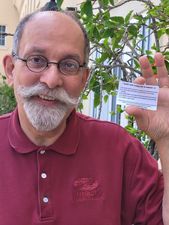 In the U.S., Steven Ferry carries in his wallet—in addition to cash—a supply of small cards created by one of a growing number of pro-cash groups that tout the benefits of physical money. He hands them to cashiers and leaves them on checks at restaurants.
In the U.S., Steven Ferry carries in his wallet—in addition to cash—a supply of small cards created by one of a growing number of pro-cash groups that tout the benefits of physical money. He hands them to cashiers and leaves them on checks at restaurants.
I paid cash today for a reason :-)
the cards read in part. Using cash can be inconvenient…but what if it's worth it?
Ferry, who lives in eastern Tennessee and is semiretired, isn't opposed to credit cards but makes a point of paying with cash as often as he can. He and his wife bring hundreds of dollars on twice-monthly errand runs into town.
Among pro-cash sympathizers are the brothers behind Right Said Fred, the group known for 1991 hit I'm Too Sexy.
We were working with an old people's home and a homeless shelter,
said one of the brothers, Fred Fairbrass. Without cash, those people are absolutely stranded.
Brett Scott, author of Cloudmoney: Cash, Cards, Crypto and the War for our Wallets,
says a power struggle is set to grow over how people pay for stuff. McKinsey projects the digital-payments industry will be worth $3 trillion by 2026, much of it generated in Asia, particularly China. Cash, Scott argues, provides freedom, anonymity and security.
So, were there protesters when landlords stopped accepting payment in eels? -Editor
To read the complete article (subscription required), see:
Paper Money Diehards Refuse to Fold
(https://www.wsj.com/articles/cash-only-movement-apple-pay-paper-money-3814f75a)
CHINESE TEAPOT WITH DUTCH COIN TOUCH
The Antiques Trade Gazette published an article about an interesting Chinese teapot with a design copied from a Dutch coin. Coin images from the NGC World Coin Price Guide. -Editor
This rare Chinese export teapot, cover and stand is painted with the arms and motto of the Dutch Republic and the cypher of the Verenigde Oost Indische Compagnie – better known as the Dutch East India Company
The inscription reads Concordia Res Parvae Crescunt 1728.
The design is copied from one side of a silver coin (the ducatoon) issued by the company in 1728 for use in the Far East. So faithfully did the Chinese artist follow his brief that even the ribbed milling of the coin is imitated in the rim of the saucer and the mouth rim of the teapot and cover.
The service is thought to have been commissioned by the VOC to mark the launch of the new coinage and may have been used by its employees at various official bases throughout the Far East.
Several pieces reside in key museum and private collections and occasionally they come to auction. A cup and saucer of this design was sold at Christie's New York in 2012 as part of the Frellinghuysen collection of Chinese export porcelain for $9500.
To read the complete articles, see:
Chinese teapot with Dutch touch
(https://www.antiquestradegazette.com/print-edition/2023/june/2595/auction-reports/chinese-teapot-with-dutch-touch/)
Netherlands East Indies Ducaton KM# 130.1
(https://www.ngccoin.com/price-guide/world/netherlands-east-indies-ducaton-km-130.1-1728-1741-cuid-1106693-duid-1454331)



